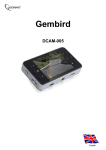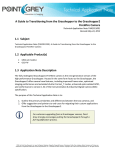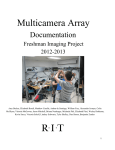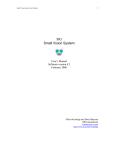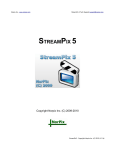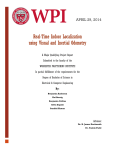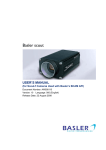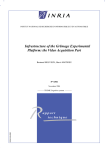Download Grasshopper
Transcript
Grasshopper ® Technical Reference Manual Version 1.6 Revised March 17, 2011 Point Grey Research® Inc. 12051 Riverside Way • Richmond, BC • Canada • V6W 1K7 • T (604) 242-9937 • www.ptgrey.com Copyright © 2010 Point Grey Research Inc. All Rights Reserved. Point Grey Research Grasshopper Technical Reference Table of Contents FCC Compliance Information This equipment has been tested and found to comply with the limits for a Class A digital device, pursuant to Part 15 of the FCC Rules. These limits are designed to provide reasonable protection against harmful interference when the equipment is operated in a commercial environment. This equipment generates, uses, and can radiate radio frequency energy and, if not installed and used in accordance with the instruction manual, may cause harmful interference to radio communications. Operation of this equipment in a residential area is likely to cause harmful interference in which case the user will be required to correct the interference at his own expense. You are cautioned that any changes or modifications not expressly approved in this manual could void your authority to operate this equipment. Hardware Warranty ® Point Grey Research Inc. (Point Grey) warrants to the Original Purchaser that the Camera Module provided with this package is guaranteed to be free from material and manufacturing defects for a period of two (2) years. Should a unit fail during this period, Point Grey will, at its option, repair or replace the damaged unit. Repaired or replaced units will be covered for the remainder of the original equipment warranty period. This warr anty does not apply to units that, after being examined by Point Grey, have been found to have failed due to customer abuse, mishandling, alteration, improper installation or negligence. If the original camera module is housed within a case, removing the case for any purpose voids this warranty. Point Grey Research, Inc. expressly disclaims and excludes all other warranties, express, implied and statutor y, including, but without limitation, warranty of merchantability and fitness for a particular application or purpose. In no event shall Point Grey Research, Inc. be liable to the Original Purchaser or any third party for direct, indirect, incidental, consequential, special or accidental damages, including without limitation damages for business interruption, loss of profits, revenue, data or bodily injur y or death. WEEE The symbol indicates that this product may not be treated as household waste. Please ensure this product is properly disposed as inappropriate waste handling of this product may cause potential hazards to the environment and human health. For more detailed information about recycling of this product, please contact Point Grey Research. Trademarks Point Grey Research, PGR, the Point Grey Research, Inc. logo, Chameleon, Digiclops, Dragonfly, Dragonfly Express, Firefly, Flea, FlyCapture, Gazelle, Grasshopper, Ladybug, and Triclops are trademarks or registered trademarks of Point Grey Research, Inc. in Canada and other countries. Revised 17-Mar-11 Copyright (c) 2010 Point Grey Research Inc. 2 Point Grey Research Grasshopper Technical Reference Table of Contents Table of Contents Table of Contents.....................................................................................3 List of Figures ..........................................................................................5 List of Tables ............................................................................................5 1 Introduction......................................................................................6 1.1. 1.2. 1.3. 1.4. 1.5. 1.6. 1.7. 1.8. 2 Camera Physical Properties .........................................................14 2.1. 2.2. 2.3. 2.4. 2.5. 2.6. 3 Grasshopper Overview ...............................................................................6 1.1.1. Image Acquisition...........................................................................6 1.1.2. Image Processing ..........................................................................6 1.1.3. Camera and Device Control ...........................................................7 1.1.4. Mechanics and Form Factor...........................................................7 Using This Manual ......................................................................................7 Camera Specifications ................................................................................8 1.3.1. Spectral Response.........................................................................9 1.3.2. Common CCD Artifacts................................................................10 1.3.3. Dual Tap Sensor Information........................................................10 System Requirements...............................................................................10 1.4.1. Laptop / Notebook Considerations ...............................................11 1.4.2. Macintosh and Linux OS Support .................................................11 Controlling the Camera .............................................................................11 1.5.1. FlyCap Demo Program ................................................................11 1.5.2. Custom Applications Built with the FlyCapture API .......................11 1.5.3. Third-Party Software Applications ................................................11 Camera Control Command Registers........................................................12 Handling Precautions and Camera Care ...................................................12 1.7.1. Case Temperature and Heat Dissipation ......................................12 Camera Accessories.................................................................................13 Physical Description..................................................................................14 Camera Dimensions .................................................................................15 Lens Setup and Compatibility....................................................................15 Dust Protection .........................................................................................16 Mounting...................................................................................................16 2.5.1. Using the Case ............................................................................16 2.5.2. Using the Tripod Mounting Bracket...............................................16 Infrared Cut-Off Filters ..............................................................................17 Camera Interface ...........................................................................18 3.1. 3.2. 3.3. 3.4. 3.5. IEEE-1394b Connector .............................................................................18 3.1.1. Daisy Chaining.............................................................................18 Cables ......................................................................................................19 Host Adapter Card ....................................................................................19 Camera Power..........................................................................................19 General Purpose Input/Output (GPIO).......................................................20 Revised 17-Mar-11 Copyright (c) 2010 Point Grey Research Inc. 3 Point Grey Research Grasshopper Technical Reference 3.6. 4 Table of Contents 3.5.1. GPIO Electrical Characteristics ....................................................21 Status Indicator LED.................................................................................21 Camera Operations and Features ................................................22 4.1. 4.2. 4.3. 4.4. 4.5. 4.6. 4.7. General Camera Properties ......................................................................23 Standard Data Formats, Modes and Frame Rates.....................................23 Frame Rates and Camera Bandwidth .......................................................25 4.3.1. Maximum Number of Cameras on a Single Bus ...........................25 4.3.2. Exceeding Bandwidth Limitations Using Format_7 with Multiple Cameras...................................................................................................26 4.3.3. Calculating Maximum Possible Frame Rate .................................26 4.3.4. Dual Packet Mode........................................................................26 Customizable Data Formats and Modes....................................................27 4.4.1. Calculating Format_7 Frame Rates..............................................34 4.4.2. Subsampling and Binning in Format_7 .........................................34 Image Acquisition .....................................................................................35 4.5.1. Camera Power.............................................................................35 4.5.2. Shutter.........................................................................................35 4.5.3. Gain.............................................................................................36 4.5.4. Auto Exposure .............................................................................36 4.5.5. Extended Shutter Times...............................................................37 4.5.6. Automatic Inter-Camera Synchronization .....................................38 4.5.7. Frame Rate Control .....................................................................38 4.5.8. Pixel Binning and Region of Interest Modes .................................38 4.5.9. Y16 (16-bit Mono) Image Acquisition............................................39 4.5.10. Asynchronous (External) Trigger Modes.....................................39 4.5.11. On-Camera Frame Buffer...........................................................41 4.5.12. High Dynamic Range (HDR) Mode.............................................42 Image Processing .....................................................................................42 4.6.1. Color and Greyscale Conversion..................................................42 4.6.2. Lookup Table and Gamma...........................................................43 4.6.3. Saturation ....................................................................................44 4.6.4. Sharpness ...................................................................................44 4.6.5. White Balance..............................................................................44 4.6.6. Image Flip / Mirror........................................................................45 4.6.7. Test Pattern .................................................................................45 4.6.8. Embedded Image Information ......................................................46 Camera and Device Control ......................................................................46 4.7.1. Voltage Sensor ............................................................................46 4.7.2. Programmable Strobe Output.......................................................46 4.7.3. RS-232 Serial Port .......................................................................46 4.7.4. Memory Channel Storage of Camera Settings..............................47 4.7.5. User Data Flash...........................................................................47 4.7.6. Camera Upgrades........................................................................47 Appendix A: Spectral Response Curves..............................................48 Appendix B: Memory Channel Registers .............................................54 Appendix C: Glossary............................................................................55 Appendix D: Technical Support Resources.........................................57 Appendix E: Contacting Point Grey Research ....................................58 Revised 17-Mar-11 Copyright (c) 2010 Point Grey Research Inc. 4 Point Grey Research Grasshopper Technical Reference List of Figures Appendix F: Revision History ...............................................................59 List of Figures Figure 1: Dimensional drawing......................................................................................15 Figure 2: IEEE-1394b connector pin configuration.........................................................18 Figure 3: GPIO schematic.............................................................................................20 Figure 4: Grasshopper external trigger timing characteristics.........................................40 Figure 5: Relationship between video mode change and triggering................................41 Figure 6: Test pattern sample image (Mono and YUV formats)......................................45 List of Tables Table 1: IEEE-1394b connector pin configuration..........................................................19 Table 2: GPIO pin assignments.....................................................................................20 Table 3: Status indicator LED descriptions ....................................................................21 Table 4: Supported video formats, modes and frame rates............................................24 Table 5: Supported partial image (Format 7) video formats and modes for GRAS-03K2C .............................................................................................................................28 Table 6: Supported partial image (Format 7) video formats and modes for GRAS-03S3M .............................................................................................................................29 Table 7: Supported partial image (Format 7) video formats and modes for GRAS-14S3C .............................................................................................................................30 Table 8: Supported partial image (Format 7) video formats and modes for GRAS-14S5C .............................................................................................................................31 Table 9: Supported partial image (Format 7) video formats and modes for GRAS-20S4C .............................................................................................................................32 Table 10: Supported partial image (Format 7) video formats and modes for GRAS-50S5C .............................................................................................................................34 Table 11: Extended shutter minimum and maximum times ............................................37 Revised 17-Mar-11 Copyright (c) 2010 Point Grey Research Inc. 5 Point Grey Research Grasshopper Technical Reference 1 Introduction 1.1. Grasshopper Overview Introduction The Grasshopper digital camera line offers high megapixel resolution and an ultra fast IEEE1394b 800Mb/s digital interface. Attractive pricing makes these powerful cameras ideal for OEMs and system integrators who need compact systems that deliver 1.4M, 2.0M or 5.0M images at high frame rates. The Grasshopper cameras are particularly effective in demanding imaging applications such as those used in electronics manufacturing, life sciences and microscopy, surveillance and security, and ITS. Users are encouraged to download TAN2007004 from www.ptgrey.com/products/grasshopper for detailed information on how to transition applications from the Scorpion to the Grasshopper. Refer to Knowledge Base Article 206 for a complete overview of the features and benefits of the IEEE-1394b standard. L All model-specific information presented in this manual reflects functionality available in firmware version 0.9.1.48. To check the camera firmware version, consult our knowledge base: www.ptgrey.com/support/kb/index.asp?a=4&q=94. 1.1.1. Image Acquisition Feature Description IEEE-1394b Bandwidth Automatic Synchronization Programmable Exposure Fast Frame Rates Multiple Trigger Modes Trigger at Full Frame Rate 800Mb/s interface allows full color RGB output at high data rates Multiple Grasshoppers on the same 1394b bus automatically sync User-programmable shutter, gain, and black clamp settings via software Faster standard frame rates plus pixel binning and ROI support Bulb-trigger mode, multiple triggered exposures before readout Overlapped trigger input, image acquisition and transfer 1.1.2. Image Processing Feature Description Color Conversion Image Processing Image Flip / Mirror Embedded Image Info Test Pattern On-camera conversion to YUV411, YUV422 and RGB formats On-camera control of sharpness, hue, saturation, gamma, LUT Horizontal image flip (mirror image) Pixels contain frame-specific info (e.g. shutter, 1394 cycle time) Continuous static image for testing and development Revised 17-Mar-11 Copyright (c) 2010 Point Grey Research Inc. 6 Point Grey Research Grasshopper Technical Reference 1.1.3. Introduction Camera and Device Control Feature Description Auto White Balance Frame Rate Control Improved Strobe Output RS-232 Serial Port Memory Channels Broadcast Properties Voltage Sensor Camera Upgrades Auto and one-push white balance for easy color balancing Fine-tune frame rates for video conversion (e.g. PAL @ 24 FPS) Increased drive strength, configurable strobe pattern output Provides serial communication via GPIO TTL digital logic levels Non-volatile storage of camera default power-up settings Apply settings (e.g. shutter, gain) to all cameras on the same bus Monitors sensor voltages to ensure optimal image quality Firmware upgradeable in field via IEEE-1394 interface. 1.1.4. Mechanics and Form Factor Feature Description Compact Design Industry Standard Mechanics Jack Screw Connector 44mm x 29mm x 58mm, 104 grams ASA/ISO-compliant mounting bracket and C-mount lens holder 1394b cable jack screws provide secure connection 1.2. Using This Manual This manual attempts to provide the user with a detailed specification of the Grasshopper camera system. The reader should be aware that the camera system is a complex and dynamic system – if any errors or omissions are found during experimentation, please contact us. This document is subject to change without notice. Many of the operational descriptions included in this manual are intended as general overviews, and may not present the detailed information required for developing specific applications. For additional details and operational descriptions, refer to the following resources that can be downloaded from our website at www.ptgrey.com/support/downloads/: • • • • • • • • • Point Grey Digital Camera Register Reference FlyCapture User Manual TAN2004004: Synchronizing to an external signal using DCAM 1.31 Trigger Mode_0 TAN2004001: Configuring and testing the RS-232 serial port TAN2005002: Setting a GPIO pin to strobe using DCAM 1.31 Strobe Signal Output TAN2005003: Setting a GPIO pin to output a strobe signal pulse pattern TAN2005004: Buffering a GPIO pin output signal to drive an external device TAN2007004: A guide to transitioning from Scorpion® to Grasshopper® TAN2007004: Accessing the On-Camera Frame Buffer Revised 17-Mar-11 Copyright (c) 2010 Point Grey Research Inc. 7 Point Grey Research Grasshopper Technical Reference 1.3. Introduction Camera Specifications Specification 03K2 Imaging Sensor Maximum Resolution Sensor Pixel Size Maximum FPS Digital Interface Transfer Rates A/D Converter Max Pixel Clock Video Data Output Image Data Formats Partial Image Modes 03S3 Kodak® KAI- Sony® ICX414 1/2” 0340ABB/CBA-CB- progressive AA-Dual 1/3” scan CCD progressive scan CCD 640(H) x 480 (V) 7.4 x 7.4µm 14S3 14S5 20S4 Sony® ICX267 1/2” progressive scan CCD Sony® ICX285 2/3” progressive scan CCD Sony® ICX274 Sony® ICX625 1/1.8” 2/3” progressive progressive scan CCD scan CCD 50S5 648(H) x 488(V) 9.9 x 9.9µm 1384(H) x 1384(H) x 1624(H) x 2448(H) x 1032(V) 1036(V) 1224(V) 2048(V) 4.65 x 4.65µm 6.45 x 4.4 x 4.4µm 3.45 x 3.45µm 6.45µm See sections 4.2 and 4.4 for more information Dual bilingual 9-pin IEEE-1394b for camera control, video data transmission and daisy chaining 100, 200, 400, 800 Mbit/s Analog Devices 14-bit analog-to-digital converter 40 MHz 26 MHz 40 MHz 28 MHz 67 MHz 32 MHz 8, 16 and 24-bit digital data (see Supported Data Formats) Y8, Y16 (all models), RGB, YUV411, YUV422, YUV444, 8-bit and 16-bit raw Bayer data (color models) Pixel binning and region of interest modes available via Format_7 8-pin Hirose HR25 general purpose input/output connector 4 pins for external trigger, strobe or serial data / 1 pin +3.3V / 1 VEXT pin to externally power the camera Automatic / manual / one-push gain modes Gain 0dB to 24dB Automatic / manual / one-push shutter modes Programmable through software or through input trigger signal Shutter 0.02ms to 66.63ms @ 15 FPS Extended shutter modes for exposure times longer than 5 seconds Image On-board raw Bayer color interpolation, hue, saturation, sharpness, gamma, programmable Processing LUT, horizontal image flip, test pattern output Gamma 0.50 to 4.00 Trigger Modes DCAM v1.31 Trigger Modes 0, 1, 3, 14, and 15 * Signal To 56 dB 64 dB 60 dB 65 dB 59 dB 57 dB Noise Ratio * Peak QE 460 nm 500 nm 459 nm 470 nm 460 nm 520 nm Wavelength 46 % 45 % 52 % 64 % 60 % 56 % * Peak QE Value * Full Well 19426 e31370 e9159 e16964 e13942 e6486 eDepth * Dark Noise 21.57 e-/s 13.61 e-/s 0.53 e-/s 6.38 e-/s 9.39 e-/s 3.19 e-/s * Dark Current 187 e-/s 331 e-/s 1.84 e-/s 175 e-/s 122 e-/s 34 e-/s * Read Noise 84 e41 e59 e33 e61 e78 e* Average 46 °C 37 °C 45 °C 36 °C 42 °C 38 °C General Purpose I/O Revised 17-Mar-11 Copyright (c) 2010 Point Grey Research Inc. 8 Point Grey Research Grasshopper Technical Reference Operating Temperature Dimensions Mass Lens Mount Camera Specification Voltage Requirements Power Requirements (max) Emissions Compliance Operating Temperature Storage Temperature Warranty Operating Relative Humidity Storage Relative Humidity Introduction 44mm x 29mm x 58mm (excluding lens holder, without optics) 104 grams (without optics) C-mount IIDC 1394-based Digital Camera Specification v1.31 8-30V, via IEEE-1394b interface or 8-pin GPIO connector 3.9W 2.9W 3.0W 3.1W 3.4W 3.8W Complies with CE rules and Part 15 Class A of FCC Rules 0° to 40°C -30° to 60°C Two years 20 to 80% (no condensation) 20 to 95% (no condensation) * Measurements taken under the following conditions: Gain: 0 dB; Pixel Format: Format_7 Mode 0; Resolution: Max; Frame Rate: Max; Shutter: 1 ms; 1.3.1. L Spectral Response All color models are equipped with an optical filter that prevents infrared light from reaching the image sensor. This filter is discussed in the section on Infrared Cut-Off Filters. For spectral response curves, see Appendix A: Spectral Response Curves. Revised 17-Mar-11 Copyright (c) 2010 Point Grey Research Inc. 9 Point Grey Research Grasshopper Technical Reference 1.3.2. Introduction Common CCD Artifacts The following section describes issues typical of CCD sensors and possible solutions. • Dead / Hot Pixels It is possible for one or more pixels in the CCD sensor array to stop responding. This will result in a situation where the pixel will always appear black (dead), or white (hot/stuck). This is generally not an issue except in very rare cases. • Bright Pixels Cosmic rays have the ability to cause images to have artifacts which look like hot pixels which are randomly distributed throughout the image. This is most apparent when the camera is running at a high temperature or the gain is set to a high amount. It is impossible to prevent cosmic rays from reaching the CCD. • Vertical Smear When a strong light source is shot on the camera, there may be a vertical smear above and below the position of the actual light source. This is a byproduct of the interline transfer system used to extract data from the CCD. 1.3.3. Dual Tap Sensor Information The Grasshopper 50S5M/C and 03K2M/C models feature dual tap CCDs. This means that the CCD has two outputs running simultaneously in order to provide a larger data rate, thus resulting in a higher frame rate. However, the CCD is generally unable to provide the left and right halves of the image at an equal intensity. Therefore in order to maintain image quality, the Grasshopper has been calibrated to correct for imbalances between the left and right halves. However, there may be situations where the boundary between the left and right halves of the images can be seen, such as images with high gain values. 1.4. System Requirements • • • • • • Processor ® Recommended – Intel Pentium 4 2.0 GHz or compatible processor Minimum – Intel Pentium III 800 MHz or compatible processor Memor y Recommended – 2GB Minimum - 256MB AGP video card with 64 MB video memory (128 MB recommended) Bus Configuration Recommended – PCI Express (PCI-e card not included) or 64-bit PCI slot Minimum – 32-bit standard PCI slot for the IEEE-1394 card Microsoft Windows XP Service Pack 1 Microsoft Visual C++ 6.0 (to compile and run example code) Revised 17-Mar-11 Copyright (c) 2010 Point Grey Research Inc. 10 Point Grey Research Grasshopper Technical Reference 1.4.1. Introduction Laptop / Notebook Considerations Some 1394 PCMCIA cards for laptop / notebook computers require a 4-pin cable. A 4-pin cable does not provide power and will therefore not work with Point Grey cameras, which require a 6-pin connector (the additional two pins provide power). For suggestions on how to provide power in these circumstances, consult the following knowledge base article: KB Article 93: 1.4.2. www.ptgrey.com/support/kb/index.asp?a=4&q=93 Macintosh and Linux OS Support Users wishing to operate their Point Grey camera on the Macintosh OS/X or Linux operating systems should consult the following knowledge base articles: Macintosh support: Linux support: 1.5. www.ptgrey.com/support/kb/index.asp?a=4&q=173 www.ptgrey.com/support/kb/index.asp?a=4&q=17 Controlling the Camera The Grasshopper can be controlled by the following types of applications: 1.5.1. FlyCap Demo Program The FlyCap application is a generic streaming image viewer included with the FlyCapture® SDK that can be used to test many of the capabilities of your compatible PGR IEEE-1394 camera. It allows you to view a live video stream from the camera, save individual images or .avi movie clips, adjust the various video formats, frame rates, properties and settings of the camera, and access camera registers. It is an easy-to-use program that can be used to test many of the capabilities of your PGR IEEE-1394 camera system. Consult the PGR FlyCapture User Manual for more information. 1.5.2. Custom Applications Built with the FlyCapture API PGR FlyCapture includes a full Application Programming Interface that allows customers to create custom applications to control Point Grey Imaging Products. The SDK provides a number of sample programs and source code that is meant to help the advanced programmer get started using the FlyCapture API. Examples range from simple console programs that demonstrate the basic functionality of the API, such as PGRFlyCaptureTest, to more complex examples such as the MFC application FlyCap. 1.5.3. Third-Party Software Applications The following k nowledge base article provides information on Point Grey IEEE-1394 camera compatibility with third-party software development kits, applications, camera drivers, and integrated development environments (IDEs): KB Article 152: Revised 17-Mar-11 Copyright (c) 2010 Point Grey Research Inc. www.ptgrey.com/support/kb/index.asp?a=4&q=152 11 Point Grey Research Grasshopper Technical Reference 1.6. Introduction Camera Control Command Registers For a complete description of the Camera Control Command Registers implemented on the camera, please refer to the Point Grey Research Digital Camera Register Reference, included with the FlyCapture SDK and downloadable from www.ptgrey.com/support/downloads/. 1.7. Handling Precautions and Camera Care [ Do not open the camera housing. Doing so voids the Hardware Warranty described at the beginning of this reference manual. Your Point Grey digital camera module is a precisely manufactured device and should be handled with care. Here are some tips on how to care for the device. • Avoid electrostatic charging. Please consult the following knowledge base article for more details: www.ptgrey.com/support/kb/index.asp?a=4&q=42. • Users who have purchased a bare board camera should take the following additional protective measures: o o Either handle bare handed or use non-chargeable gloves, clothes or material. Also, use conductive shoes. Install a conductive mat on the floor or working table to prevent the generation of static electricity. • When handling the camera unit, avoid touching the lenses. Fingerprints will affect the quality of the image produced by the device. • To clean the lenses, use a standard camera lens cleaning kit or a clean dry cotton cloth. Do not apply excessive force. • To clean the imaging surface of your CCD, www.ptgrey.com/support/kb/index.asp?a=4&q=66. • Our cameras are designed for an office environment or laboratory use. Extended exposure to bright sunlight, rain, dusty environments, etc. may cause problems with the electronics and the optics of the system. • Avoid excessive shaking, dropping or any kind of mishandling of the device. 1.7.1. follow the steps outlined in Case Temperature and Heat Dissipation The Grasshopper is an ultra-compact camera. As a result of packing the Grasshopper electronics into a small space, the outer case of the camera can become very warm to the touch when running in some high data rate video modes. The case can reach temperatures up to 45° Celsius under normal operating conditions. This is expected behaviour and will not damage the camera electronics. Revised 17-Mar-11 Copyright (c) 2010 Point Grey Research Inc. 12 Point Grey Research Grasshopper Technical Reference Introduction If reducing heat is a concern, users can use a cooling fan to set up a positive air flow around the camera, taking into consideration the following precautions: • • • 1.8. Mount the camera on a heat sink, such as a camera mounting bracket, made out of a heat-conductive material like aluminum. Make sure the flow of heat from the camera case to the bracket is not blocked by a nonconductive material like plastic. Make sure the camera has enough open space around it to facilitate the free flow of air. Camera Accessories Accessories such as tripod mounts and lens holders are available from PGR – contact our Sales team at [email protected] for additional information. Link s to FireWire/IEEE-1394 and digital camera accessories can be found in the following knowledge base article: KB Article 131: Revised 17-Mar-11 Copyright (c) 2010 Point Grey Research Inc. www.ptgrey.com/support/kb/index.asp?a=4&q=131. 13 Point Grey Research Grasshopper Technical Reference Camera Physical Properties 2 Camera Physical Properties 2.1. Physical Description 6 7 1 8 3 5 3 4 2 1. Lens holder (Cmount) Attach any C-mount lens or other optical equipment. Consult the section Lens Setup and Compatibility for full details. 2. Glass / IR filter system Refer to the Dust Protection and the Infrared Cut-Off Filters section for more information. 3. M3x0.5 mounting holes Refer to the Mounting section for full details. Revised 17-Mar-11 Copyright (c) 2010 Point Grey Research Inc. 4. General Purpose I/O connector The 8-pin GPIO connector is used for external triggering, strobe output or digital I/O. Refer to the General Purpose Input/Output section for more information. 5. Status LED This light indicates the current state of the Grasshopper operation. Refer to the section Status Indicator LED. 6. IEEE-1394b connector 7. IEEE-1394b connector The camera uses standard 9-pin 1394b connectors. M3 screw holes are located on either side of the connectors for secure connections to the 9-pin locking 1394b cable. See the IEEE-1394 Connector section for full connector details. 8. M3x0.5 mounting holes Refer to the Mounting section for full details. 14 Point Grey Research Grasshopper Technical Reference 2.2. Camera Physical Properties Camera Dimensions Figure 1: Dimensional drawing 2.3. Lens Setup and Compatibility The lens holder is compatible with C-mount lenses. Lenses are not included with individual cameras. To differentiate between C- and CS-mount lenses, consult the following article: KB Article 98: Revised 17-Mar-11 Copyright (c) 2010 Point Grey Research Inc. www.ptgrey.com/support/kb/index.asp?a=4&q=98 15 Point Grey Research Grasshopper Technical Reference 2.4. Camera Physical Properties Dust Protection [ Cameras are sealed when they are shipped. To avoid contamination, seals should not be brok en until cameras are ready for assembly at customer's site. Do not remove the protective glass. Doing so can void the Hardware Warranty described at the beginning of this reference manual. The case is designed to prevent dust from falling directly onto the CCD's protective glass surface. This is achieved by placing a piece of clear glass (monochrome camera models) or IR cut-off filter (color models) that sits above the surface of the CCD's glass. A removable plastic retainer keeps this glass/filter system in place. By increasing the distance between the imaging surface and the location of the potential dust par ticles, the likelihood of interference from the dust (assuming noncollimated light) and the possibility of damage to the sensor during cleaning is reduced. 2.5. Mounting 2.5.1. Using the Case The case is equipped with the following mounting holes: • • Two (2) M3x0.5mm mounting holes on the top of the case Four (4) M3x0.5mm mounting holes on the bottom of the case that can be used to attach the camera directly to a custom mount or to the Grasshopper tripod mounting bracket 2.5.2. Using the Tripod Mounting Bracket The Grasshopper tripod mounting bracket comes with the Development Kit, or can be purchased separately by contacting [email protected]. The bracket is equipped with four (4) M3 mounting holes. Revised 17-Mar-11 Copyright (c) 2010 Point Grey Research Inc. 16 Point Grey Research Grasshopper Technical Reference 2.6. Camera Physical Properties Infrared Cut-Off Filters Point Grey Research color camera models are equipped with an additional infrared (IR) cut-off filter. This filter can reduce sensitivity in the visible spectrum. The properties of this filter are illustrated in the results below, which were obtained by Point Grey Research independent of camera model. In monochrome models, the IR filter is replaced with a transparent piece of glass. 1 The following are the properties of the IR filter/protective glass : Type Material Physical Filter Size Glass Thickness Dimensional Tolerance Coating Filters 1 Reflective Schott D 263 T or BK7 equivalent for coating filters 14 mm x 14 mm 1.0 mm +/-0.1 mm` Scott D 263 T These properties apply to all imaging cameras except GRAS 14S5. Related Knowledge Base Articles ID Title 98 Understanding flange back distance on C-mount and CSmount cameras Revised 17-Mar-11 Copyright (c) 2010 Point Grey Research Inc. URL www.ptgrey.com/support/kb/index.asp?a=4&q=98 17 Point Grey Research Grasshopper Technical Reference 3 Camera Interface 3.1. IEEE-1394b Connector Camera Interface The camera has 2 standard 9-pin IEEE-1394b connectors (pin configuration shown below) that is used for data transmission, camera control and powering the camera. For more detailed information, consult the IEEE-1394b Standard document available from www.1394ta.org. For a full description of the features and benefits of 1394b, refer to Knowledge Base Article 206. 3.1.1. Daisy Chaining As the camera has 2 IEEE-1394b connectors, it is possible to connect multiple cameras (and/or hubs) in a daisy-chained manner. This allows multiple cameras to be easily connected to a single host controller. However, the maximum bandwidth available for all cameras is still restricted to 800Mbps (for IEEE-1394b) or 400Mbps (for IEEE-1394a). L While the Grasshopper is an IEEE-1394b device, it is backward compatible with the IEEE-1394a 400Mb/s standard, and can therefore be connected to any 1394a OHCI host adapter using a 9- to 6-pin cable (included with Grasshopper Development Kits). Figure 2: IEEE-1394b connector pin configuration Pin 1 2 3 4 5 6 7 8 9 Revised 17-Mar-11 Copyright (c) 2010 Point Grey Research Inc. Signal Name TPBTPB+ TPATPA+ TPA (R) VG SC VP TPB (R) Comment Twisted Pair B (Minus) Twisted Pair B (Plus) Twisted Pair A (Minus) Twisted Pair A (Plus) Twisted Pair A (Reference Ground) Power (Ground) Status Contact (Reserved for Future Use) Power (Voltage) Twisted Pair B (Reference Ground) 18 Point Grey Research Grasshopper Technical Reference Camera Interface Table 1: IEEE-1394b connector pin configuration 3.2. Cables The maximum 1394 cable length between any 1394 node (e.g. camera to PCI card, PCI card to hub, etc.) is 4.5m, as specified by the IEEE- 1394 standard. Standard, shielded twisted pair copper cables must be used. Consult the following knowledge base article for infor mation on how to extend the physical distance between the camera and the controlling host system: KB Article 197: 3.3. www.ptgrey.com/support/kb/index.asp?a=4&q=197 Host Adapter Card All camera KITs (e.g. part numbers ending with “KIT”) com e with a 3-port IEEE-1394 PCI host adapter card. For more information regarding the differences between various 1394 host adapters, consult the following knowledge base article: KB Article 146: 3.4. www.ptgrey.com/support/kb/index.asp?a=4&q=146 Camera Power The 9-pin 1394b interface connects to a standard IEEE-1394 (FireWire) 9-pin cable and provides a power connection between the camera and the host computer. The ideal input voltage is 12V DC; however, the camera is designed to handle voltages between 8V and 30V DC. The power consumption is outlined in the Camera Specifications section. Some systems - such as laptop computers or those with several FireWire devices connected require an external power supply to power the camera. For suggestions on how to provide power in these circumstances, consult the following knowledge base article: KB Article 93: www.ptgrey.com/support/kb/index.asp?a=4&q=93 Some PGR cameras allow the user to power-up or power-down components of the camera using the DCAM CAMERA_POWER register 0x610. The exact components, e.g. image sensor, A/D converter, other board electronics, will vary between camera models. Consult the PGR IEEE1394 Digital Camera Register Reference for more information. When a camera is power cycled (power disengaged then re-engaged), the camera will revert to its default factory settings, or if applicable, the last saved memory channel. Revised 17-Mar-11 Copyright (c) 2010 Point Grey Research Inc. 19 Point Grey Research Grasshopper Technical Reference 3.5. Camera Interface General Purpose Input/Output (GPIO) The Grasshopper has an 8-pin GPIO connector on the back of the case. The connector is a Hirose HR25 8 pin connector (Mfg P/N: HR25-7TR-8SA). KIT contents include a prewired male connector; refer to the diagram below for wire color-coding. Additional male connectors (Mfg P/N: HR25-7TP-8P) can be purchased from Digikey (P/N: HR702-ND). Diagram Pin Function Function 1 2 3 4 5 6 7 8 IO0 IO1 IO2 IO3 GND GND VEXT +3.3V Input / Output (default Trigger_Src) Input / Output Input / Output / RS232 Transmit (TX) Input / Output / RS232 Receive (RX) Allows the camera to be powered externally Power external circuitry up to 150mA Table 2: GPIO pin assignments Figure 3: GPIO schematic Inputs can be configured to accept external trigger signals. Outputs can be configured to send an output signal, strobe, or PWM signal. To use the RS232 functionality, a level converter must be used to convert the TTL digital logic levels to RS232 voltage levels. B&B Electronics (http://www.bb-elec.com/) part number 232LPTTL can be used for this conversion. For more information on using the RS232 serial port, download Technical Application Note TAN2004001 from www.ptgrey.com/support/downloads/. Revised 17-Mar-11 Copyright (c) 2010 Point Grey Research Inc. 20 Point Grey Research Grasshopper Technical Reference 3.5.1. Camera Interface GPIO Electrical Characteristics The Grasshopper GPIO pins are TTL 3.3V pins. When configured as inputs, the pins are internally pulled high using weak pull-up resistors to allow easy triggering of the camera by simply shorting the pin to ground (GND). Inputs can also be directly driven from a 3.3V or 5V logic output. The inputs are protected from both over and under voltage. It is recommended, however, that they only be connected to 5V or 3.3V digital logic signals. When configured as outputs, each line can sink 10mA of current. To drive external devices that require more, consult the following article for information on buffering an output signal using an optocoupler: KB Article 200: www.ptgrey.com/support/kb/index.asp?a=4&q=200 The VEXT pin (Pin 7) allows the camera to be powered externally. The voltage limit is 8-30V, and current is limited to 1A. The +3.3V pin is fused at 150mA. External devices connected to Pin 8 should not attempt to pull anything greater than that. 3.6. Status Indicator LED LED Status Maximum red (Initial connection) Maximum red (During operation) Dull Red Bright Red Dull Green Bright Green Dull Yellow Bright Yellow Red/Green flashing Description Initial startup. On until camera is initialized. Condition 1: Bus Rest. On for 0.66s. Condition 2: Power failure. On until power-up via CAMERA_POWER 0x610. Configuration error. Configuration error. Camera is idle. Firewire activity. On for 0.5s during activity. Powered down. Powered down + activity. On for 0.5s during activity. Camera firmware is being updated. Flashes at 5Hz. Table 3: Status indicator LED descriptions Revised 17-Mar-11 Copyright (c) 2010 Point Grey Research Inc. 21 Point Grey Research Grasshopper Technical Reference 4 Camera Operations and Features Camera Operations and Features The Grasshopper line of IEEE-1394 cameras complies with the IIDC 1394-based Digital Camera (DCAM) Specification Version v1.31. To determine the specific DCAM v1.31 features implemented in a particular Grasshopper model, consult the following sections of the PGR IEEE-1394 Digital Camera Register Reference. Inquiry Registers for Basic Functions Inquiry Registers for Feature Presence Inquiry Registers for Feature Elements You can query the registers described in these sections to identify whether specific features have been implemented. For a complete description of the Camera Control Command Registers implemented on the Grasshopper, please refer to the PGR IEEE-1394 Digital Camera Register Reference, included with the PGR FlyCapture SDK and downloadable from www.ptgrey.com/support/downloads/. Revised 17-Mar-11 Copyright (c) 2010 Point Grey Research Inc. 22 Point Grey Research Grasshopper Technical Reference 4.1. Camera Operations and Features General Camera Properties The following section provides an overview of the camera properties implemented by the Grasshopper. Descriptions of some of the following properties and how they are implemented can be found in this Technical Reference. Refer to the PGR IEEE-1394 Digital Camera Register Reference for additional definitions and descriptions of: • • “Auto”, “On/Off” and “One Push” - Control and Status Registers for Features section “Absolute Mode” - Absolute Value CSR Registers section The following property ranges apply to a Grasshopper GRAS-50S5C running at 15 FPS, and can change depending on the camera resolution and frame rate: • • • Shutter / Extended Shutter: maximum values increase as frame rate decreases Pan / Tilt: maximum values increase with smaller non-Format_7 resolutions Frame Rate: range changes according to the current frame rate L Properties marked with a ‘(COL)’ apply to color models only and are not implemented on cameras using a monochrome sensor. Property Units Min Max Auto On/Off Brightness Auto Exposure Sharpness White Balance Hue (COL) Saturation (COL) Gamma Pan Tilt Shutter Gain Trigger Delay Frame Rate Extended Shutter % EV 0 1 deg % 0 -7.58 4095 1023 -180 0 0.5 0 0 0.02 -4.50 0 0.49 0.02 6.24 2.41 Y Y 179.91 399.9 4 848 848 66.64 24.00 65.00 16.52 63312.04 N Y Y Y Y Y Y Y Y N N Y Y N Y N Y N Y N Y Y Y Y N Y 4.2. ms dB s fps ms One Push N Y N N N N N N N Y Y N N Absolute Mode Y Y Y Y Y N N Y Y Y Y Standard Data Formats, Modes and Frame Rates This section lists the different video formats, modes and frame rates that are supported by the Grasshopper. Refer to the Customizable Formats and Modes for a list of supported partial image (Format_7) modes. These standard modes are controlled using the following IIDC registers: • • • CURRENT_VIDEO_FORMAT register 0x608 CURRENT_VIDEO_MODE register 0x604 CURRENT_FRAME_RATE register 0x600 Revised 17-Mar-11 Copyright (c) 2010 Point Grey Research Inc. 23 Point Grey Research Grasshopper Technical Reference L Camera Operations and Features Images acquired by color cameras using Y8 or Y16 modes (or Format_7 Mono8 / Mono16 modes) are converted to greyscale (monochrome) on-board the camera. To access the raw Bayer data to apply different color conversion algorithms or one of the FlyCapture library algorithms, refer to the Color and Greyscale Conversion section of this manual. L Some smaller format / mode combinations (e.g. 1280x960 Y8 on an GRAS-20S4C) currently run at 5/6th of the frame rate reported in the following table (e.g. 25 FPS instead of 30 FPS). Table 4: Supported video formats, modes and frame rates • • • Models: Modes 03K2M 14S5C 50S5C 1.875fps • • • 3.75fps 160x120 YUV444 320x240 YUV422 640x480 YUV411 640x480 YUV422 640x480 RGB 640x480 Y16 640x480 Y8 •••• •••• •••• •••• ••••• ••• ••••• ••• 800x600 YUV422 800x600 RGB 800x600 Y16 800x600 Y8 1024x768 YUV422 •••• •••• •••• •••• ••••• ••• ••••• ••• ••• •••••• •••• Revised 17-Mar-11 Copyright (c) 2010 Point Grey Research Inc. •••• 03K2C 14S5M • • 03S3M 20S4C • • 14S3M • 14S3C 20S4M 50S5M 7.5fps 15fps •• •••• •••• •••• •••• ••••• ••• ••••• ••• ••• ••• •••••• •••••• •••• •• •••• •••• •••• •••• •••••• ••• •••••• ••• ••• ••• •••••• •••••• •••• 30fps 60fps •• • ••• • ••• • ••• • ••• •••••• ••••• ••• •••••• ••••• ••• •• •• •• •••• 120fps • • 24 Point Grey Research Grasshopper Technical Reference 1024x768 RGB 1024x768 Y16 1024x768 Y8 1280x960 YUV422 1280x960 RGB 1280x960 Y16 1280x960 Y8 1600x1200 YUV422 1600x1200 RGB 1600x1200 Y16 1600x1200 Y8 4.3. •••• •••• •••• •••• •••• ••• ••• •••••• •••••• •• •• •••• •••• •••• •••• •••• •••• •••• ••• ••• •••••• •••••• •• •• •••• •••• •••• •••• •••• •••• •••• ••• ••• •••••• •••••• •• •• •••• •••• Camera Operations and Features ••• •••• •••• •••• •••• ••• ••• •••••• •••••• •• •••••• •••• ••• •••• •••• Frame Rates and Camera Bandwidth [ 4.3.1. This section is recommended for advanced users only, and is not meant to address all possible applications of the Grasshopper camera. Maximum Number of Cameras on a Single Bus A single IEEE-1394 OHCI host adapter generally constitutes a single “bus”. There are four elements that limit the number of cameras that can be used on the same 1394 bus: • Although the 1394b standard limits the maximum number of simultaneous isochronous channels to 16, there is currently no host adapter that is capable of supporting 16 channels. Host adapters based on the LSI chipset such as the FirePRO™ 1394b PCI Express card can support up to 8 simultaneous DMA channels (or contexts). Host adapters based on the TI chipset can support at most 4 simultaneous DMA channels (or contexts). There are no known 1394b chipsets that allow 16 simultaneous DMA contexts. See Knowledge Base Article 146 for more information. • The maximum bandwidth of the 1394b bus is 800Mbits/sec (10240Bytes/packet - 8000 cycles/sec). The usable bandwidth as defined by the 1394 Trade Association and enforced by the Microsoft Windows 1394 driver stack (1394bus.sys, ohci1394.sys, etc.) is approximately 80% or 80MBytes/sec (8192 bytes/packet). The remaining 20% of the bandwidth is allocated for asynchronous communication (e.g. register reads/writes). Outside of the Microsoft stack, it may be possible to allocate up to 9830 bytes/packet. Revised 17-Mar-11 Copyright (c) 2010 Point Grey Research Inc. 25 Point Grey Research Grasshopper Technical Reference Camera Operations and Features • The 1394b standard limits the maximum number of devices on a single bus to 63. • An inadequate power supply. Consult the voltage and power requirements in the General Specifications section to determine the amount of power required to operate the cameras effectively. 4.3.2. Exceeding Bandwidth Limitations Using Format_7 with Multiple Cameras There is a mechanism for effectively bypassing IEEE-1394 bus bandwidth negotiation when using cameras in Format 7 partial image mode. This functionality is useful in any situation where the user is trying to host multiple cameras on the same bus in a configuration that would normally exceed the bandwidth allocation, but where the cameras are configured to transmit data in a manner that does not exceed the total bandwidth. For additional information, see Knowledge Base Article 256. 4.3.3. Calculating Maximum Possible Frame Rate The maximum frame rate allowable for each of the cameras on the bus depends on the resolution of the cameras and the frame rate, and can be roughly approximated using the following general formula (assuming all cameras are at the same resolution): Frames_per_second = (Bandwidth / (Pixels_per_frame * Bytes_per_pixel)) / Num_cameras Example: To calculate the approximate frames per second available to three 1024x768 Grasshoppers that are in 16-bit mode, you would calculate: Frames_per_second = (80MB/s / (1024*768*2bytes/pixel)) / 3 = (80MB/s / 1.5MB/frame) / 3 = 53.33 FPS / 3 = 17.8 FPS The calculation above is only a rough estimate. The DCAM standard defines a specific number of bytes per packet (BPP) for every non-Format_7 video format/mode/frame rate combination. This number is generally higher than the minimum bandwidth that might be expected. In order to accurately determine whether or not there is enough bandwidth available for a given scenario, these numbers must be used. The BPP can be derived using the Isochronous Bandwidth Requirements section of the PGR IEEE-1394 Digital Camera Register Reference. For example, a single Grasshopper in 640x480 RGB mode running at 15 FPS is sending 640 pixels per packet. Each pixel consists of 24 bits, or 3 bytes, of data. Therefore, the camera is sending 640*3 = 1920Bpp of data. The maximum bandwidth of the 1394b bus as discussed above is 8192Bpp, so it would be possible for 8192/1920 = 4 (rounded down) Grasshopper’s to run in 640x480 RGB mode at 15 FPS on the same 1394b bus. 4.3.4. Dual Packet Mode The Grasshopper is capable of sending a maximum of 9568Bpp (8-bit 5MP images at 15fps). However, the 1394 specification only allows 8192Bpp, so the Grasshopper splits each packet that Revised 17-Mar-11 Copyright (c) 2010 Point Grey Research Inc. 26 Point Grey Research Grasshopper Technical Reference Camera Operations and Features is over 8192Bpp into two smaller packets per isochronous period. This feature is unique to the Grasshopper and requires software support to work properly. For more information on this feature, please see Knowledge Base Article 276. 4.4. Customizable Data Formats and Modes The table below outlines the Format_7 custom image modes that are supported by the Grasshopper. The implementation of these modes and the frame rates that are possible are not specified by the DCAM, and are subject to change across firmware versions. Mode_0, Mode 1, Mode_6 and Mode 7 are region of interest (sub-window) modes that allow the user to only transmit a selected area of the image. Mode_1 is a pixel binning (subsampling) mode. Color binning is supported in the 14S3C and 20S4C models. Refer to the Pixel Binning and Region of Interest Modes section for information on mode implementation. Moving the position of region of interest to a different location does not require the camera to be stopped (isochronous transmission disabled) and restarted (iso enabled), unless the change is illegal (e.g. moving the ROI outside the imaging area) or would affect the isochronous packet size. Changing the size of the image or the pixel encoding format does require the stop/start procedure. Ignoring the time required to do this in software (tearing down, then reallocating, image buffers, write times to the camera, etc.), the maximum amount of time required for the stop/start procedure is slightly more than one frame time. L The sizes and frame rates supported by monochrome (BW) models are identical to the color models specified below, with the exception that only Mono8 and Mono16 are supported. Images acquired by color cameras using Mono8 or Mono16 modes are converted to greyscale (monochrome) on-board the camera. Users interested in accessing the raw Bayer data to apply their own color conversion algorithm or one of the FlyCapture library algorithms should refer to the Color and Greyscale Conversion section of this manual. GRAS-03K2C Max BPP (Max Size) Min BPP (Max Size) Unit Size (H,V) Mode Pixel Format 0 Mono8 8,2 4 2760 0 Mono16 8,2 4 5520 0 Raw8 8,2 160 8960 0 Raw16 8,2 320 9600 Revised 17-Mar-11 Copyright (c) 2010 Point Grey Research Inc. Max Resolution FPS 61 640x480 61 640x480 200 640x480 121 640x480 640 x 480 FPS 320 x 240 FPS 160 x 120 FPS 61 105 168 61 105 168 200 341 538 121 341 538 27 Point Grey Research Grasshopper Technical Reference 0 YUV411 8,2 4 4140 0 YUV422 8,2 4 5520 0 YUV444 8,2 8 8280 0 RGB8 8,2 8 8280 1 Mono8 4,2 36 4032 1 Mono16 4,2 68 8024 1 YUV411 4,2 24 2832 1 YUV422 4,2 4 1376 1 YUV444 4,2 4 2068 1 RGB8 4,2 4 2068 6 Mono8 8,2 4 2760 6 Mono16 8,2 4 5520 6 Raw8 8,2 132 7524 6 Raw16 8,2 264 9768 6 YUV411 8,2 4 4140 6 YUV422 8,2 4 5520 6 YUV444 8,2 8 8280 6 RGB8 8,2 8 8280 7 Mono8 8,2 4 2760 7 Mono16 8,2 4 5520 7 Raw8 8,2 4 2760 7 Raw16 8,2 4 5520 7 YUV411 8,2 4 4140 7 YUV422 8,2 4 5520 7 YUV444 8,2 8 8280 7 RGB8 8,2 8 8280 61 640x480 61 640x480 61 640x480 61 640x480 343 320x240 343 320x240 167 320x240 61 320x240 61 320x240 61 320x240 61 640x480 61 640x480 167 640x480 123 640x480 61 640x480 61 640x480 61 640x480 61 640x480 61 640x480 61 640x480 61 640x480 61 640x480 61 640x480 61 640x480 61 640x480 61 640x480 Camera Operations and Features 61 105 168 61 105 168 61 105 168 61 105 168 - 343 512 - 343 512 - 167 285 - 61 105 - 61 105 - 61 105 61 105 168 61 105 168 167 284 450 123 284 450 61 105 168 61 105 168 61 105 168 61 105 168 61 105 168 61 105 168 61 105 167 61 105 167 61 105 168 61 105 168 61 105 168 61 105 168 Table 5: Supported partial image (Format 7) video formats and modes for GRAS-03K2C Revised 17-Mar-11 Copyright (c) 2010 Point Grey Research Inc. 28 Point Grey Research Grasshopper Technical Reference Camera Operations and Features GRAS-03S3M Mode Pixel Format Unit Size (H,V) Min BPP (Max Size) Max BPP (Max Size) 0 Mono8 8,2 4 2644 0 Mono16 8,2 4 5292 1 Mono8 4,2 4 1212 1 Mono16 4,2 4 2424 2 Mono8 8,2 4 2424 2 Mono16 8,2 4 4852 7 Mono8 8,2 4 3008 7 Mono16 8,2 4 6020 Max Resolution FPS 640 x 480 FPS 320 x 240 FPS 160 x 120 FPS 65 85 101 65 85 101 - 115 116 - 115 116 - 115 116 - 115 116 75 134 224 75 134 224 64 (648 x 488) 64 (648 x 488) 114 (324 x 244) 114 324 x 244( 114 (648 x 244) 114 (648 x 244) 74 (648x488) 74 (648x488) Table 6: Supported partial image (Format 7) video formats and modes for GRAS-03S3M GRAS-14S3C Max BPP (Max Size) 8,2 4 3828 0 Mono16 8,2 8 7656 0 Raw8 8,2 4 3828 0 Raw16 8,2 8 7656 0 YUV411 8,2 8 5744 0 YUV422 8,2 8 7656 0 YUV444 8,2 16 9792 0 RGB8 8,2 16 9792 1 Mono8 4,2 4 1628 1 Mono16 4,2 4 3256 Revised 17-Mar-11 Copyright (c) 2010 Point Grey Research Inc. 21 1384x1032 21 1384x1032 21 1384x1032 21 1384x1032 21 1384x1032 21 1384x1032 18 1384x1032 18 1384x1032 35 692x516 35 692x516 160 x 120 FPS Min BPP (Max Size) Mono8 320 x 240 FPS Unit Size (H,V) 0 Max Resolution FPS 640 x 480 FPS Pixel Format 1280 x 960 FPS Mode 22 41 71 111 22 41 71 111 22 41 71 111 22 41 71 111 22 41 71 111 22 41 71 111 21 41 71 111 21 41 71 111 - 37 64 98 - 37 64 98 29 Point Grey Research Grasshopper Technical Reference 1 Raw8 4,2 4 1628 1 Raw16 4,2 4 3256 1 YUV411 4,2 4 2440 1 YUV422 4,2 4 3256 1 YUV444 4,2 4 4884 1 RGB8 4,2 4 4884 2 Mono8 8,2 4 3256 2 Mono16 8,2 4 6512 2 Raw8 8,2 4 3256 2 Raw16 8,2 4 6512 2 YUV411 8,2 4 4884 2 YUV422 8,2 4 6512 2 YUV444 8,2 8 9768 2 RGB8 8,2 8 9768 35 692x516 35 692x516 35 692x516 35 692x516 35 692x516 35 692x516 35 1384x516 35 1384x516 35 1384x516 35 1384x516 35 1384x516 35 1384x516 35 1384x516 35 1384x516 Camera Operations and Features - 37 64 98 - 37 64 98 - 37 64 98 - 37 64 98 - 37 64 98 - 37 64 98 - 37 64 98 - 37 64 98 - 37 64 98 - 37 64 98 - 37 64 98 - 37 64 98 - 37 64 98 - 37 64 98 Table 7: Supported partial image (Format 7) video formats and modes for GRAS-14S3C GRAS-14S5C Max BPP (Max Size) 8,2 4 2676 0 Mono16 8,2 8 5352 0 Raw8 8,2 4 2676 0 Raw16 8,2 8 5352 0 YUV411 8,2 8 4008 0 YUV422 8,2 8 5352 0 YUV444 8,2 16 8016 0 RGB8 8,2 16 8016 Revised 17-Mar-11 Copyright (c) 2010 Point Grey Research Inc. 15 1384x1036 15 1384x1036 15 1384x1036 15 1384x1036 15 1384x1036 15 1384x1036 15 1384x1036 15 1384x1036 16 29 48 74 16 29 48 74 16 28 47 74 16 28 47 74 16 29 48 74 16 29 48 74 16 29 48 74 16 29 48 74 160 x 120 FPS Min BPP (Max Size) Mono8 320 x 240 FPS Unit Size (H,V) 0 Max Resolution FPS 640 x 480 FPS Pixel Format 1280 x 960 FPS Mode 30 Point Grey Research Grasshopper Technical Reference 1 Mono8 4,2 4 1368 1 Mono16 4,2 4 2740 1 YUV411 4,2 4 1000 1 YUV422 4,2 4 1336 1 YUV444 4,2 4 2004 1 RGB8 4,2 4 2004 2 Mono8 8,2 4 1336 2 Mono16 8,2 4 2676 2 YUV411 8,2 4 2004 2 YUV422 8,2 4 2676 2 YUV444 8,2 8 4008 2 RGB8 8,2 8 4008 Camera Operations and Features 29 692x518 29 692x518 15 692x518 15 692x518 15 692x518 15 692x518 15 1384x518 15 1384x518 15 1384x518 15 1384x518 15 1384x518 15 1384x518 - 31 52 82 - 31 52 82 - 16 29 48 - 16 29 48 - 16 29 48 - 16 29 48 - 16 29 48 - 16 29 48 - 16 29 48 - 16 29 48 - 16 29 48 - 16 29 48 Table 8: Supported partial image (Format 7) video formats and modes for GRAS-14S5C GRAS-20S4C 8 5104 0 Mono16 8,2 16 9792 0 Raw8 8,2 8 7512 0 Raw16 8,2 16 9792 0 YUV411 8,2 12 7656 0 YUV422 8,2 16 9792 0 YUV444 8,2 24 9792 0 RGB8 8,2 24 9792 1 Mono8 4,2 4 3448 Revised 17-Mar-11 Copyright (c) 2010 Point Grey Research Inc. 20 1624x1224 19 1624x1224 30 1624x1224 19 1624x1224 20 1624x1224 19 1624x1224 13 1624x1224 13 1624x1224 53 812x612 160 x 120 FPS 8,2 320 x 240 FPS Mono8 640 x 480 FPS 0 Max Resolution FPS 1280 x 960 FPS Pixel Format 1600 x 1200 FPS Max BPP (Max Size) Min BPP (Max Size) Unit Size (H,V) Mode 20 25 46 78 119 20 25 46 78 119 30 37 68 115 176 20 31 68 115 176 20 25 46 78 119 20 25 46 78 119 13 21 46 78 119 13 21 46 78 119 - - 65 110 165 31 Point Grey Research Grasshopper Technical Reference 1 Mono16 4,2 4 6900 1 Raw8 4,2 4 3448 1 Raw16 4,2 4 6900 1 YUV411 4,2 4 3536 1 YUV422 4,2 4 4716 1 YUV444 4,2 4 7076 1 RGB8 4,2 4 7076 2 Mono8 8,2 4 4664 2 Mono16 8,2 8 9328 2 Raw8 8,2 4 6804 2 Raw16 8,2 8 9792 2 YUV411 8,2 4 7000 2 YUV422 8,2 8 9328 2 YUV444 8,2 16 9792 2 RGB8 8,2 16 9792 53 812x612 53 812x612 53 812x612 36 812x612 36 812x612 36 812x612 36 812x612 36 1624x612 36 1624x612 53 1624x612 38 1624x612 36 1624x612 36 1624x612 26 1624x612 26 1624x612 Camera Operations and Features - - 65 110 165 - - 65 110 165 - - 65 110 165 - - 44 75 114 - - 44 75 114 - - 44 75 114 - - 44 75 114 - - 44 75 114 - - 44 75 114 - - 65 110 165 - - 65 110 165 - - 44 75 114 - - 44 75 114 - - 44 75 114 - - 44 75 114 Table 9: Supported partial image (Format 7) video formats and modes for GRAS-20S4C GRAS-50S5C 8 6192 0 Mono16 8,2 16 9792 0 Raw8 8,2 16 9568 0 Raw16 8,2 24 9792 0 YUV411 8,2 16 9296 0 YUV422 8,2 16 9792 0 YUV444 8,2 24 9792 Revised 17-Mar-11 Copyright (c) 2010 Point Grey Research Inc. 14 2448x2048 2448x2048 2448x2048 2448x2048 2448x2048 2448x2048 2448x2048 160 x 120 FPS 8,2 320 x 240 FPS Mono8 640 x 480 FPS 0 Max Resolution FPS 1280 x 960 FPS Pixel Format 1600 x 1200 FPS Max BPP (Max Size) Min BPP (Max Size) Unit Size (H,V) Mode 23 27 44 63 80 20 27 44 63 80 23 28 44 63 80 20 27 44 63 80 23 27 44 63 80 20 27 44 63 80 13 21 44 63 80 32 Point Grey Research Grasshopper Technical Reference 0 RGB8 8,2 24 9792 1 Mono8 4,2 4 3036 1 Mono16 4,2 8 6072 1 Raw8 4,2 4 3644 1 Raw16 4,2 8 7288 1 YUV411 4,2 4 4566 1 YUV422 4,2 8 6072 1 YUV444 4,2 8 9112 1 RGB8 4,2 8 9112 2 Mono8 8,2 4 5064 2 Mono16 8,2 8 9792 2 Raw8 8,2 7 7288 2 Raw16 8,2 16 9792 2 YUV411 8,2 8 7592 2 YUV422 8,2 8 9792 2 YUV444 8,2 16 9792 2 RGB8 8,2 16 9792 3 Mono8 4,2 8 3984 3 Mono16 4,2 12 7980 3 Raw8 4,2 8 4784 3 Raw16 4,2 16 9568 3 YUV411 4,2 8 5984 3 YUV422 4,2 12 7980 3 YUV444 4,2 16 9792 3 RGB8 4,2 16 9792 7 Mono8 2,2 8 920 Revised 17-Mar-11 Copyright (c) 2010 Point Grey Research Inc. 2448x2048 22 1224x1024 22 1224x1024 22 1224x1024 22 1224x1024 22 1224x1024 22 1224x1024 20 1224x1024 20 1224x1024 22 2448x1024 2448x1024 2448x1024 2448x1024 2448x1024 2448x1024 2448x1024 2448x1024 15 1224x2048 15 1224x2048 15 1224x2048 15 1224x2048 15 1224x2048 15 1224x2048 10 1224x2048 10 1224x2040 45 612x512 Camera Operations and Features 13 21 44 63 80 - - 37 51 64 - - 37 51 64 - - 37 51 64 - - 37 51 64 - - 37 51 62 - - 37 51 62 - - 37 51 62 - - 37 51 62 - 23 37 51 62 - 23 37 51 62 - 23 37 51 64 - 23 37 51 64 - 23 37 51 62 - 23 37 51 62 - 21 37 51 62 - 21 37 51 62 - - 44 63 80 - - 44 63 80 - - 44 63 80 - - 44 63 80 - - 44 63 80 - - 44 63 80 - - 44 63 80 - - 44 63 80 - - - 61 72 33 Point Grey Research Grasshopper Technical Reference 7 Mono16 2,2 16 1844 45 612X512 Camera Operations and Features - - - 61 71 Table 10: Supported partial image (Format 7) video formats and modes for GRAS-50S5C L 4.4.1. The maximum resolution currently supported by the GRAS-50S5C when using a mode that performs color processing on board (e.g. Mono8, YUV422, RGB) is 2040x2040. In order to access the full 2048x2048 array, Raw8 or Raw16 modes must be used. See Knowledge Base Article 276 for instructions on how to access the full sensor array. Calculating Format_7 Frame Rates The theoretical frame rate (FPS) that can be achieved given the number of packets per frame (PPF) can be calculated as follows: FPS = 1 Packets per Frame * 125us An estimate for the number of packets per frame can be determined according to the following: PPF = Image_Size * Bytes_Per_Pixel Bytes_Per_Packet For the exact number of packets per frame, query the PACKET_PER_FRAME_INQ register; for the number of bytes per packet, query the BYTE_PER_PACKET register. For example, assuming an image size of 1032x776, pixel format of Mono16 (2 bytes per pixel), and 3072 bytes per packet, the calculation would be as follows: FPS = 1 / ( ( 1032*776*2 / 3072 ) * 0.000125 ) FPS = 1 / ( 521 / 8000 ) FPS = 15.34 An interactive bandwidth calculator is available in Knowledge Base Article 22. It can be used to calculate approximate bandwidth requirements for various DCAM modes. 4.4.2. Subsampling and Binning in Format_7 Depending on the Format_7 imaging parameters, the camera may be performing image manipulation operations such as subsampling or binning. The read-only FORMAT_7_RESIZE_INQ register at 0x1AC8 contains information pertinent to the current Format_7 mode such as whether standard or bayer binning is being performed on the image. For more detailed information on the FORMAT_7_RESIZE_INQ register, please see the PGR IEEE-1394 Digital Camera Register Reference. Revised 17-Mar-11 Copyright (c) 2010 Point Grey Research Inc. 34 Point Grey Research Grasshopper Technical Reference 4.5. Camera Operations and Features Image Acquisition 4.5.1. Camera Power The Grasshopper allows the user to power-up or power-down components of the camera using the CAMERA_POWER register 0x610. The exact components, e.g. image sensor, A/D converter, other board electronics, will vary between camera models. By default, power is OFF both at startup and reinitialization. After writing 0x10000000 to register 0x610 to power-up the camera, the camera automatically reports a value of 0x00000001 until power up is complete. The default power-up delay time is 100 ms, or two frame times. The maximum delay is 1 s. On GRAS-03K2 models, the default delay time is 250 ms. The camera does not keep or transmit any images acquired during power-up, regardless of isochronous or asynchronous transmission mode. The auto-exposure algorithm does not run while the camera is powered down. It may therefore take several (n) images to get a satisfactory image, where n is undefined. 4.5.2. Shutter The Grasshopper supports automatic, manual and one-push control of the CCD shutter time. Refer to the General Specifications section for detailed information on supported shutter time ranges. Shutter times are scaled by the divider of the basic frame rate. For example, dividing the frame rate by two (e.g. 15 FPS to 7.5 FPS) causes the maximum shutter time to double (e.g. 66ms to 133ms). Formulas for converting the fixed point (relative) shutter values reported by SHUTTER register 0x81C to floating point (absolute) values are not provided. Users wishing to work with real-world values should refer to the Absolute Value CSR Registers section of the PGR IEEE-1394 Digital Camera Register Reference. L The terms “integration” and “exposure” are often used interchangeably with “shutter”. The time between the end of shutter for consecutive frames will always be constant. However, if the shutter time is continually changing (e.g. shutter is in Auto mode being controlled by Auto Exposure), the time between the beginning of consecutive integrations will change. If the shutter time is constant, the time between integrations will also be constant. The Grasshopper will continually expose and read image data off of the sensor under the following conditions: 1. The camera is powered up (see Camera Power above); and 2. The camera is not in asynchronous trigger mode. When in async trigger mode, the camera simply clears the sensor and does not read the data off the sensor. It is important to note that the camera will continue exposing images even when isochronous data transfer is disabled and images are not being streamed to the PC. The camera continues Revised 17-Mar-11 Copyright (c) 2010 Point Grey Research Inc. 35 Point Grey Research Grasshopper Technical Reference Camera Operations and Features exposing images even when ISO is off in order to keep things such as the auto exposure algorithm (if enabled) running. This is done to ensure that when a user starts requesting images (ISO turned on), the first image they receive will be properly exposed. 4.5.3. Gain The Grasshopper supports automatic, manual and one-push gain modes. The A/D converter provides a PxGA gain stage (white balance / preamp) and VGA gain stage (GAIN register 0x820). The main VGA gain stage is available to the user, and is variable from 0 to 24dB in steps of 0.046db. Formulas for converting the fixed point (relative) gain values reported by GAIN register 0x820 to floating point (absolute) values are not provided. Users wishing to work with real-world values should refer to the Absolute Value CSR Registers section of the PGR IEEE-1394 Digital Camera Register Reference. L Increasing gain also increases image noise, which can affect image quality. To increase image intensity, try adjusting the lens aperature (iris) and shutter time first. L The GRAS-20S4M/C models are limited to 16dB of gain when running in 30fps mode. It is possible to manually override this limit by setting the ABS_VALUE_GAIN register. 4.5.4. Auto Exposure Auto exposure (AE) allows the camera to automatically control shutter and/or gain in order to achieve a specific average image intensity, and is controlled using the AUTO_EXPOSURE register 0x804. There are three AE states: State Off On Manual AE On Auto AE Description Control of the exposure is achieved via setting shutter and/or gain. The camera automatically modifies shutter and/or gain to try and match the average image intensity to one-quarter of the specified AE value. The camera modifies the AE value in order to produce an image that is visually pleasing. If only one of shutter and gain is in auto mode, the auto exposure controller attempts to control the image intensity using that one parameter. If both of these parameters are in auto mode, the auto exposure controller uses a shutter-before-gain heuristic to try and maximize the signal-tonoise ratio by favoring a longer shutter time over a larger gain value. The auto exposure algorithm is only applied to the active region of interest, and not the entire array of active pixels. Revised 17-Mar-11 Copyright (c) 2010 Point Grey Research Inc. 36 Point Grey Research Grasshopper Technical Reference Camera Operations and Features It is also possible to force the camera to perform the auto exposure algorithm on a certain ROI within the image. Please see the documentation for the AE_ROI register located at 0x1A70 to 0x1A74 in the PGR IEEE-1394 Digital Camera Register Reference. 4.5.5. Extended Shutter Times The maximum shutter time for the Grasshopper can be extended beyond the normal shutter range by setting the ON_OFF bit [6] of the FRAME_RATE register 0x83C to zero (OFF). Once the FRAME_RATE is turned off, you should see the Max_Value of the ABS_VAL_SHUTTER register increase. L Model GRAS-03K2M GRAS-03K2C GRAS-03S3M GRAS-14S3M GRAS-14S3C GRAS-14S5M GRAS-14S5C GRAS-20S4M GRAS-20S4C GRAS-50S5M GRAS-50S5C The maximum extended shutter time reported by the SHUTTER_INQ register 51Ch is capped at 4095 (0xFFF), the maximum value allowed by the Max_Value field of this register. Use the Max_Value of the ABS_VAL_SHUTTER register to determine the maximum shutter. Format and FPS 640x480 Y8, 60 FPS 640x480 Y8, 30 FPS 640x480 Y8, 15 FPS 640x480 Y8, 60 FPS 640x480 Y8, 30 FPS 640x480 Y8, 15 FPS 640x480 Y8, 7.5 FPS 640x480 Y8, 3.75 FPS 640x480 Y8, 1.875 FPS 1280x960 Y8, 15 FPS 1280x960 Y8, 7.5 FPS 1280x960 Y8, 3.75 FPS 1280x960 Y8, 1.875 FPS 1280x960 Y8, 15 FPS 1280x960 Y8, 7.5 FPS 1280x960 Y8, 3.75 FPS 1280x960 Y8, 1.875 FPS 1600x1200 Y8, 30 FPS 1600x1200 Y8, 15 FPS 1600x1200 Y8, 7.5 FPS 1600x1200 Y8, 3.75 FPS 1600x1200 Y8, 1.875 FPS 1600x1200 Y8, 15 FPS 1600x1200 Y8, 7.5 FPS 1600x1200 Y8, 3.75 FPS 1600x1200 Y8, 1.875 FPS Min (ms) 0.02 0.02 0.02 0.02 0.02 0.02 0.02 0.02 0.02 0.02 0.02 0.02 0.02 0.02 0.02 0.02 0.02 0.02 0.02 0.02 0.02 0.02 0.02 0.02 0.02 0.02 Max (ms) 2132 2132 2132 2046 3271 3271 3271 24540 49080 4225 6543 6543 16300 4629 6543 6543 24540 1775 3442 6543 3543 26175 2777 5554 6543 19631 Notes Table 11: Extended shutter minimum and maximum times Revised 17-Mar-11 Copyright (c) 2010 Point Grey Research Inc. 37 Point Grey Research Grasshopper Technical Reference Related Knowledge Base Articles ID Title 166 Extended shutter mode operation for DCAM 1.31compliant PGR Imaging Products. 4.5.6. Camera Operations and Features URL www.ptgrey.com/support/kb/index.asp?a=4&q=166 Automatic Inter-Camera Synchronization Multiple Point Grey FireWire cameras, when they are on the same IEEE-1394 bus and running at the same frame rate, are automatically synchronized to each other at the hardware level. When using multiple cameras, the timing of one camera to another camera is as follows: • If the cameras are on the same bus, the cameras are synchronized to within 125µs (microseconds) of each other (note: 125µs is the maximum deviation). However, the 1394 bandwidth limits the maximum number of cameras that can be on one bus. See the section Maximum Number of Cameras on a Single 1394 Bus for more information. • If the cameras are on s eparate buses, use PointGrey’s MultiSync software to synchronize the cameras across buses . This can be used to synchronize cameras on different buses within the same computer or on different buses across multiple computers. The software will ensure that the cameras are synchronized to within 125µs. If Multisync is not running, there is no timing correlation between separate cameras on separate buses. ™ It is possible to offset the synchronization of individual cameras relative to other cameras using the TRIGGER_DELAY register 0x834. Related Knowledge Base Articles ID Title 112 Synchronizing PGR cameras across multiple PCs 4.5.7. URL www.ptgrey.com/support/kb/index.asp?a=4&q=112 Frame Rate Control The current base frame rate is controlled using the CURRENT_FRAME_RATE register 0x600. The Grasshopper allows users to further “fine-tune” the frame rates of their cameras using the FRAME_RATE register 0x83C, which is described in detail in the PGR IEEE-1394 Digital Camera Register Reference. This is particularly useful for capturing an image stream at a different frame rate than those outlined in the Supported Data Formats and Modes section, and can be useful for synchronizing to 50Hz light sources, which can cause image intensity fluctuations due to the light source oscillations being out of sync with the frame rate. For example, users may wish to play an image stream back on a PAL-based system that displays at 25 FPS. To do this, set the CURRENT_FRAME_RATE to 30 FPS, set the A_M_Mode bit [7] of the FRAME_RATE register 0x83C to zero (manual), then adjust the value using the Value field or using the ABS_VAL_FRAME_RATE register (recommended). 4.5.8. Pixel Binning and Region of Interest Modes The Grasshopper implements several DCAM Format_7 customizable video modes (see the Customizable Formats and Modes section for camera-specific information) that allow for faster Revised 17-Mar-11 Copyright (c) 2010 Point Grey Research Inc. 38 Point Grey Research Grasshopper Technical Reference Camera Operations and Features frame rates based on selecting a specific region of interest (ROI) of the image or by configuring the camera to sub-sample the image using a process known as “pixel binning”. Related Knowledge Base Articles ID Title 163 What are the differences between pixel binning and region of interest custom image modes? 4.5.9. URL www.ptgrey.com/support/kb/index.asp?a=4&q=163 Y16 (16-bit Mono) Image Acquisition The Grasshopper can output Y16 (16 bit-per-pixel) mono images. However, the number of bits of usable data is limited to 12, or 4095 possible values, by the following: • • A 14-bit A/D converter. On-camera adjustment of sharpness and gamma; on color models, white balance adjustment and color processing are also involved. To obtain 14 bits of usable data, or 65,532 possible values, output images in Raw16 format using one of the following methods: • • Acquire images in Y16 format, and set IMAGE_DATA_FORMAT register 0x1048 to 1. Acquire images in a Format_7 Raw16 format. the Bayer_Mono_Ctrl field of the Consult the PGR IEEE-1394 Digital Camera Register Reference for more information. L To determine the number of bits of useable image data, and resulting signal-to-noise ratio, that is actually being produced by the A/D converter, see www.ptgrey.com/support/kb/index.asp?a=4&q=170. The PGM file format can be used to correctly save 16-bit images. However, there are very few photo manipulation/display applications that can correctly display true 16-bit images. XV in Linux and Adobe Photoshop are two possibilities. 4.5.10. Asynchronous (External) Trigger Modes The Grasshopper provides a number of different asynchronous trigger modes, which allows the start of exposure (shutter) to be initiated by an external electrical source (hardware trigger) or camera register write (software trigger). Supported modes include: 0, 1, 3, 14 and 15. These modes and their operation are described in greater detail in the PGR IEEE-1394 Digital Camera Register Reference. 4.5.10.1. External Trigger Timing The time from the external trigger going low to the start of shutter is shown below: Revised 17-Mar-11 Copyright (c) 2010 Point Grey Research Inc. 39 Point Grey Research Grasshopper Technical Reference Camera Operations and Features 1 n min 1μs o less than 10μs p shutter time q 1ms r 30ms (30 FPS) External trigger Exposure time 3 2 Data transfer 4 5 Figure 4: Grasshopper external trigger timing characteristics It is possible for users to measure this themselves by configuring one of the camera’s GPIO pins to output a strobe pulse (see the Programmable Strobe Output section) and connecting an oscilliscope up to the input trigger pin and the output strobe pin. The camera will strobe each time an image acquisition is triggered; the start of the strobe pulse represents the start of exposure. 4.5.10.2. Ensuring Trigger is Armed It is possible for the Grasshopper to be in asynchronous trigger mode but not be ready to accept a trigger. The reason for this is that the camera may be currently exposing an image; the camera is only ready to be triggered again when this image finishes integrating and is completely read off of the CCD. To ensure that the camera is ready to be triggered, poll the SOFTWARE_TRIGGER register 0x62C or SOFT_ASYNC_TRIGGER register 0x102C. The concept of polling to ensure the trigger is armed is demonstrated in the AsyncTriggerEx example program distributed with the FlyCapture SDK. Once the trigger is reporting that it is armed, there should be no delay between when the user can enable isochronous transmission and when they can trigger the camera. In fact, it is possible to trigger the camera before iso is enabled and receive the image that was triggered, provided iso is enabled at some point during exposure. For example, assuming a 10ms shutter time, it is possible to trigger the camera, enable iso 5ms after, and still receive the triggered image. Related Knowledge Base Articles ID Title 169 Time between software trigger and start of integration. 177 Maximum frame rate possible in external trigger mode_0. 221 Synchronizing to an external signal using DCAM 1.31 Trigger_Mode_0 4.5.10.3. URL www.ptgrey.com/support/kb/index.asp?a=4&q=169 www.ptgrey.com/support/kb/index.asp?a=4&q=177 www.ptgrey.com/support/kb/index.asp?a=4&q=221 Minimum Trigger Pulse Length The minimum trigger pulse length than the camera will respond to is 16 ticks of the current pixel clock. The pixel clock frequency can be read from the floating point PIXEL_CLOCK_FREQ register 0x1AF0. Revised 17-Mar-11 Copyright (c) 2010 Point Grey Research Inc. 40 Point Grey Research Grasshopper Technical Reference 4.5.10.4. Camera Operations and Features Changing Video Modes While Triggering You can change the video format and mode of the camera while operating the camera in trigger mode. Note that subsequent triggers may be ignored for a period of time, depending on the nature of the mode/format change and the frequency of triggering. Figure 5 shows the relationship between changing video modes and triggering. Figure 5: Relationship between video mode change and triggering Any request to change video mode following the end of shutter integration of the last-triggered image (point A) causes subsequent triggers to be ignored until the video mode reconfiguration completes. Note that this configuration does not begin until the end of sensor readout of the lasttriggered image (point B), and can last up to 10 ms, especially if the request involves a change in pixel clock speed. If, for some reason, sensor readout is delayed, the maximum time period that triggers are ignored is 1.5 s. To determine if the camera is ready to accept a trigger, read bit 0 of SOFTWARE_TRIGGER register 0x62C. A value of 0 indicates readiness. For more information, see Section 4.5.10.2. L 4.5.11. The effects of missed triggers due to a video mode change are likely to be felt most acutely when triggering in ‘overlapped exposure/readout mode’ (Mode 14). On-Camera Frame Buffer The Grasshopper has 32MB of memory that can be used for temporary image storage. This may be useful in cases such as: Revised 17-Mar-11 Copyright (c) 2010 Point Grey Research Inc. 41 Point Grey Research Grasshopper Technical Reference Camera Operations and Features 1. Retransmission of an image is required due to data loss or corruption. 2. Multiple camera systems where there is insufficient bandwidth to capture images in the desired configuration. This feature is controlled using the Frame Buffer register located at 0x12E8. For more information, please see TAN2007004: Accessing the On-Camera Frame Buffer. 4.5.12. High Dynamic Range (HDR) Mode The Grasshopper can be set into a High Dynamic Range mode in which the camera will rotate between 4 user-defined shutter and gain settings. This allows images representing a wide range of shutter and gain settings to be collected in a short time to be combined into a final HDR image later. The Grasshopper does not create the final HDR image; this must be done by the user. The format of the HDR registers is as follows: Offset Register 0x1800 HDR control register 0x1820 HDR shutter register for image 0 0x1824 HDR gain register for image 0 0x1840 HDR shutter register for image 1 0x1844 HDR gain register for image 1 0x1860 HDR shutter register for image 2 0x1864 HDR gain register for image 2 0x1880 HDR shutter register for image 3 0x1884 HDR gain register for image 3 Remarks Toggle bit [6] to enable/disable HDR Similar to SHUTTER register 0x81C Similar to GAIN register 0x820 Similar to SHUTTER register 0x81C Similar to GAIN register 0x820 Similar to SHUTTER register 0x81C Similar to GAIN register 0x820 Similar to SHUTTER register 0x81C Similar to GAIN register 0x820 Please note that the on/off bit (bit [6]) for the HDR shutter and gain registers is hard-coded to on. 4.6. Image Processing 4.6.1. Color and Greyscale Conversion In order to produce color (e.g. RGB, YUV) and greyscale (e.g. Y8, Y16) images, color Grasshopper models perform on-board processing of the Bayer Tile Pattern output produced by the CCD. The color processing algorithm used by the Grasshopper is most similar to the Edge Sensing algorithm implemented by the PGR FlyCapture library, which weights surrounding pixels based on localized edge orientations. The primary differences are the emphasis placed on the edges and the user-configurable Sharpness filter. To convert the Bayer Tile Pattern to greyscale, the Grasshopper adds the value for each of the RGB components in the color processed pixel to produce a single greyscale (Y) value for that pixel, as follows: Y = R/4 + G/2 + B/4 For a full description of how Bayer Tiled color sensors and color filter arrays work, refer to Knowledge Base Article 89 (http://www.ptgrey.com/support/kb/index.asp?a=4&q=89). 4.6.1.1. Accessing Raw Bayer Data Users interested in accessing the raw Bayer data to apply their own color conversion algorithm or one of the FlyCapture library algorithms, should acquire images using one of the Format_7 video modes that support Raw8 or Raw16 pixel encoding. See the Customizable Formats and Modes Revised 17-Mar-11 Copyright (c) 2010 Point Grey Research Inc. 42 Point Grey Research Grasshopper Technical Reference Camera Operations and Features section for further information on acquiring images using these modes. An alternative to this is to use the Bayer_Mono_Ctrl bit [24] of the IMAGE_DATA_FORMAT register 0x1048. Setting this bit to 1 enables raw Bayer output in non-Format_7 Y8 / Y16 modes, or Format_7 Mono8 / Mono16 modes. The actual physical arrangement of the red, green and blue "pixels" for a given camera is determined by the arrangement of the color filter arrays on the imaging sensor itself. For example, the CFA format of a Sony ICX204AK color CCD can be found in the "Block Diagram and Pin Configuration" section of its datasheet. The format (i.e. order) in which this raw color data is streamed out, however, depends on the specific camera model and firmware version. This format can be queried using the BAYER_TILE_MAPPING register 0x1040 that is implemented on all PGR cameras. Raw image data can be accessed programmatically via the pData pointer in the FlyCaptureImage structure (e.g. FlyCaptureImage.pData). In Raw8 modes, the first byte represents the pixel at (row 0, column 0), the second byte at (row 0, column 1), etc. In the case of a 1600x1200 color Grasshopper that is streaming out Raw8 image data in RGGB format, if we access the image data via the pData pointer we have the following: • • • • pData[0] = Row 0, Column 0 = red pixel (R) pData[1] = Row 0, Column 1 = green pixel (G) pData[1600] = Row 1, Column 0 = green pixel (G) pData[1601] = Row 1, Column 1 = blue pixel (B) Related Knowledge Base Articles ID Title 33 Different color processing algorithms. 37 Writing color processing software and color interpolation algorithms. 89 How is color processing performed on my camera’s images? 4.6.2. URL www.ptgrey.com/support/kb/index.asp?a=4&q=33 www.ptgrey.com/support/kb/index.asp?a=4&q=37 www.ptgrey.com/support/kb/index.asp?a=4&q=89 Lookup Table and Gamma The Grasshopper supports lookup table (LUT) and gamma functionality. CCD manufacturers strive to make the transfer characteristics of CCDs inherently linear, which means that as the number of photons hitting the imaging sensor increases, the resulting image intensity increases will be linear. The Grasshopper also provides an 11-bit input lookup table that produces 9-bit outputs. Although the camera uses a 14-bit A/D converter, the Grasshopper is only able to accommodate 11-bit 11 images. The LUT therefore allows the user to map the 2 , or 2048, different possible pixel values 9 to any one of 512 (2 ) possible output values. For example, the LUT would allow the user to map any pixel with a value of 2047 (white) to any value between 0 (black) and 512 (white). On color cameras, there are separate LUT channels for each entry, representing red, green, and blue values. Monochrome cameras have a single grayscale channel per entry. Color cameras in a monochrome (Y8) mode still require a three-channel RGB LUT because the monochrome image comes from a weighted sum of the red, green and blue pixel values (see Color and Greyscale Conversion) after the LUT has been applied. Revised 17-Mar-11 Copyright (c) 2010 Point Grey Research Inc. 43 Point Grey Research Grasshopper Technical Reference Camera Operations and Features Gamma is applied after the analog-to-digital conversion and is controlled using the GAMMA register 0x818. It can be used to apply a non-linear mapping of the resulting 11-bit image down to 9 bits. By default, Gamma is OFF and has a value of 1.0, which yields a linear response. For more information regarding the LUT CSR registers, refer to the PGR IEEE-1394 Digital Camera Register Reference. L Due to limitations in the Bayer interpolator, LUT/gamma correction is unavailable on GRAS-50S5C models in the following situations: 1. Pixel clock is greater than 50MHz. The pixel clock frequency can be read from the floating point PIXEL_CLOCK_FREQ register 0x1AF0. 2. Image width or height is greater than 2040 pixels. 3. Image data format is either Y8, Raw8 or Raw16. 4.6.3. Saturation The Grasshopper supports saturation, which refers to color saturation, as opposed to saturation of a CCD charge. Saturation is controlled using the SATURATION register 0x814 4.6.4. Sharpness The Grasshopper supports sharpness, which refers to the filtering of an image to reduce blurring at image edges. Sharpness is implemented as an average upon a 3x3 block of pixels, and is only applied to the green component of the Bayer tiled pattern. For sharpness values greather than 1000, the pixel is sharpened; for values less than 1000 it is blurred. When sharpness is in auto mode, if gain is low, then a small amount of shaping is applied, which increases as gain decreases. If the gain is high, a small amount of blur is applied, increasing as gain increases. 4.6.5. White Balance The Grasshopper supports white balance, which is a name given to a system of color correction to deal with differing lighting conditions. Adjusting the white balance by modifying the relative gain of R, G and B in an image enables white areas to look "whiter". Taking some subset of the target image and looking at the relative red to green and blue to green response, the general idea is to scale the red and blue channels so that the response is 1:1:1. The white balance scheme outlined in the IIDC specification states that blue and red are adjustable and that green is not. The blue and red values can be controlled using the WHITE_BALANCE register 0x80C. The Grasshopper also implements Auto and One_Push white balance. One of the uses of one_push / auto white balance is to obtain a similar color balance between different cameras that are slightly different from each other. Theoretically, if different cameras are pointed at the same scene, using one_push / auto will result in a similar color balance between the cameras. One_push is similar identical to auto white balance, except One-Push only attempts to automatically adjust white balance for a set period of time before stopping. The white balance of Revised 17-Mar-11 Copyright (c) 2010 Point Grey Research Inc. 44 Point Grey Research Grasshopper Technical Reference Camera Operations and Features the camera before using One-Push/Auto must already be relatively close, i.e. if Red is set to 0 and Blue is at maximum (two extremes), One-Push/Auto will not work. However, if the camera is already close to being color balanced, then it will work (it may only be a small change). One_push only attempts to automatically adjust white balance for a set period of time before stopping. It uses a “white detection” algorithm that looks for “whitish” pixels in the raw Bayer image data. One_push adjusts the white balance for a specific number of iterations; if it cannot locate any whitish pixels, it will gradually look at the whitest objects in the scene and try to work off them. It will continue this until has completed its finite set of iterations. Auto is continually adjusting white balance. It differs from one_push in that it works almost solely off the whitest objects in the scene. L 4.6.6. White balance may be unresponsive in auto mode if auto exposure is < 0.1 EV (approximately). Image Flip / Mirror The Grasshopper supports horizontal image mirroring. The mirror image operation is done on the camera using the on-board frame buffer, and is controlled using the IMAGE_DATA_FORMAT register 0x1048, which is described in detail in the PGR IEEE-1394 Digital Camera Register Reference. 4.6.7. Test Pattern The Grasshopper is capable of outputting a continuous static image for testing and development purposes. The test pattern image is inserted into the imaging pipeline immediately prior to the transfer to the on-board FIFO, and is therefore not subject to changes in hue, saturation, sharpness, white balance or gamma. Test pattern support is only available for Y8, Y16 and YUV422 video modes. The test pattern is a simple 8 bit-per-pixel counter (the pixel intensities in each column increment from 0 to 255). Figure 6: Test pattern sample image (Mono and YUV formats) The test pattern can be enabled using the TEST_PATTERN register 0x104C, which is described in detail in the PGR IEEE-1394 Digital Camera Register Reference. Revised 17-Mar-11 Copyright (c) 2010 Point Grey Research Inc. 45 Point Grey Research Grasshopper Technical Reference 4.6.8. Camera Operations and Features Embedded Image Information The Grasshopper has a feature that allows image timing and camera settings information to be embedded in the first several pixels of each image. This feature is controlled using the FRAME_INFO register 0x12F8, which is described in detail in the PGR IEEE-1394 Digital Camera Register Reference. 4.7. Camera and Device Control 4.7.1. Voltage Sensor The Grasshopper has an on-board sensor that allows the user to monitor a variety of different voltages, including the current 1394 bus voltage. This feature can be accessed using the VOLTAGE registers 0x1A50 – 0x1A54, which are described in detail in the PGR IEEE-1394 Digital Camera Register Reference. 4.7.2. Programmable Strobe Output The Grasshopper is capable of outputting a strobe pulse off one or all of its GPIO pins. By default, a pin that is configured to be a strobe output will output a pulse each time the camera begins integration of an image. Setting a strobe duration value of zero will produce a strobe pulse indicating the exposure (shutter) time. The Grasshopper can also be configured to output a variable strobe pulse pattern. The strobe pattern functionality allows users to define the frames for which the camera will output a strobe. For example, this is useful in situations where a strobe should only fire: • • • Every Nth frame (e.g. odd frames from one camera and even frames from another); or N frames in a row out of T (e.g. the last 3 frames in a set of 6); or Specific frames within a defined period (e.g. frames 1, 5 and 7 in a set of 8) Related Knowledge Base Articles ID Title 179 Setting a GPIO pin to output a signal using DCAM v1.31 strobe functionality 207 Setting a GPIO pin to output a strobe signal pulse pattern 212 GPIO strobe signal continues after isochronous image transfer stops 4.7.3. URL www.ptgrey.com/support/kb/index.asp?a=4&q=179 www.ptgrey.com/support/kb/index.asp?a=4&q=207 www.ptgrey.com/support/kb/index.asp?a=4&q=212 RS-232 Serial Port The Grasshopper is capable of serial communications at baud rates up to 115.2Kbps via the onboard logic level serial port built into the camera’s GPIO connector. To use this functionality, a level converter must be used to convert the TTL digital logic levels to RS-232 voltage levels. B&B Electronics (http://www.bb-elec.com/) part number 232LPTTL can be used for this conversion. Revised 17-Mar-11 Copyright (c) 2010 Point Grey Research Inc. 46 Point Grey Research Grasshopper Technical Reference Related Knowledge Base Articles ID Title 151 Configuring and testing the RS232 serial port 4.7.4. Camera Operations and Features URL www.ptgrey.com/support/kb/index.asp?a=4&q=151 Memory Channel Storage of Camera Settings The Grasshopper has the ability to save and restore camera settings and imaging parameters via on-board memory channels. This is useful for saving default power-up settings, such as gain, shutter, video format and frame rate, etc., that are different from the factory defaults. Memory channel 0 is used for the default factory settings that users can always restore to. The Grasshopper provides two additional memory channels for custom default settings. The camera will initialize itself at power-up, or when explicitly reinitialized, using the contents of the last saved memory channel. Attempting to save user settings to the (read-only) factory defaults channel will cause the camera to switch back to using the factory defaults during initialization. Refer to the Memory Channel Registers section in the Appendix for a full listing of all registers saved. Memory channels are configured using the following registers, which are described in detail in the PGR IEEE-1394 Digital Camera Register Reference: MEMORY_SAVE 0x618; MEM_SAVE_CH 0x620; and CUR_MEM_CH 0x624. 4.7.5. User Data Flash The Grasshopper provides the user with 512KB of flash memory for the purposes of non-volatile data storage. This is useful for saving user data such as calibration files, software license keys, etc. The memory is divided into 2048 pages, with 256 bytes available per page. This feature is controlled using the DATA_FLASH_CTRL register 0x1240, which is described in detail in the PGR IEEE-1394 Digital Camera Register Reference. 4.7.6. Camera Upgrades The firmware on the Grasshopper can be upgraded / downgraded to later / earlier versions using the UpdatorGUI program that is bundled with every firmware version available from www.ptgrey.com/support/downloads/. The latest firmware versions often include significant bug fixes and feature enhancements that may benefit some users. To determine the changes made in a specific firmware version, consult the Release Notes. For more information on updating camera firmware, consult the UpdatorGUI User Manual available in the downloads section. Revised 17-Mar-11 Copyright (c) 2010 Point Grey Research Inc. 47 Point Grey Research Grasshopper Technical Reference Appendix A: Spectral Response Curves Appendix A: Spectral Response Curves GRAS-03K2M GRAS-03K2C Revised 17-Mar-11 Copyright (c) 2010 Point Grey Research Inc. 48 Point Grey Research Grasshopper Technical Reference Appendix A: Spectral Response Curves GRAS-03S3M Revised 17-Mar-11 Copyright (c) 2010 Point Grey Research Inc. 49 Point Grey Research Grasshopper Technical Reference Appendix A: Spectral Response Curves GRAS-14S3M GRAS-14S3C Revised 17-Mar-11 Copyright (c) 2010 Point Grey Research Inc. 50 Point Grey Research Grasshopper Technical Reference Appendix A: Spectral Response Curves GRAS-14S5M GRAS-14S5C Revised 17-Mar-11 Copyright (c) 2010 Point Grey Research Inc. 51 Point Grey Research Grasshopper Technical Reference Appendix A: Spectral Response Curves GRAS-20S4M GRAS-20S4C Revised 17-Mar-11 Copyright (c) 2010 Point Grey Research Inc. 52 Point Grey Research Grasshopper Technical Reference Appendix A: Spectral Response Curves GRAS-50S5M GRAS-50S5C Revised 17-Mar-11 Copyright (c) 2010 Point Grey Research Inc. 53 Point Grey Research Grasshopper Technical Reference Appendix B: Memory Channel Registers Appendix B: Memory Channel Registers Register Name CURRENT_FRAME_RATE CURRENT_VIDEO_MODE CURRENT_VIDEO_FORMAT CAMERA_POWER CUR_SAVE_CH BRIGHTNESS AUTO_EXPOSURE SHARPNESS WHITE_BALANCE HUE SATURATION GAMMA SHUTTER GAIN IRIS FOCUS TRIGGER_MODE TRIGGER_DELAY FRAME_RATE PAN TILT ABS_VAL_AUTO_EXPOSURE ABS_VAL_SHUTTER ABS_VAL_GAIN ABS_VAL_BRIGHTNESS ABS_VAL_GAMMA ABS_VAL_TRIGGER_DELAY ABS_VAL_FRAME_RATE IMAGE_DATA_FORMAT AUTO_EXPOSURE_RANGE AUTO_SHUTTER_RANGE AUTO_GAIN_RANGE GPIO_XTRA SHUTTER_DELAY GPIO_STRPAT_CTRL GPIO_CTRL_PIN_x GPIO_XTRA_PIN_x GPIO_STRPAT_MASK_PIN_x FRAME_INFO FORMAT_7_ IMAGE_POSITION FORMAT_7_ IMAGE_SIZE FORMAT_7_ COLOR_CODING_ID FORMAT_7_ BYTE_PER_PACKET Revised 17-Mar-11 Copyright (c) 2010 Point Grey Research Inc. Offset 600h 604h 608h 610h 620h 800h 804h 808h 80Ch 810h 814h 818h 81Ch 820h 824h 828h 830h 834h 83Ch 884h 888h 908h 918h 928h 938h 948h 958h 968h 1048h 1088h 1098h 10A0h 1104h 1108h 110Ch 1110h, 1120h, 1130h, 1140h 1114h, 1124h, 1134h, 1144h 1118h, 1128h, 1138h, 1148h 12F8h 008h 00Ch 010h 044h 54 Point Grey Research Grasshopper Technical Reference Appendix C: Glossary Appendix C: Glossary Term Definition 1394a An Institute of Electrical and Electronics Engineers (IEEE) interface standard capable of transferring data at a rate of 400Mbit per second. An IEEE interface standard capable of transferring data at a rate of 800Mbit per second. Real-world values, such as milliseconds (ms), decibels (dB) or percent (%). Using the absolute values is easier and more efficient than applying complex conversion formulas to integer values. Often abbreviated as ADC or A/D converted, it is a device that converts a voltage to a digital number. Application Programming Interface. Essentially a library of software functions. The transfer of image data from the camera to the PC that is regulated by an external signal, such as a trigger. Asynchronous transfers do not guarantee when data will be transferred. However, they do guarantee that data will arrive as sent. Asynchronous transfers may be used when data integrity is a higher priority than speed. An example might be an image data transfer to a printer, where speed is less critical than getting the image pixels correct. Asynchronous transfers are initiated from a single node, designated the ‘requestor’, to or from the address space of another node, designated the ‘responder’. Asynchronous requests are packet-based. The requestor node generates a request packet that the 1394 bus sends to the responder node. The responder node is responsible for handling the request packet and creating a response packet that is sent back to the requestor node to complete a single transfer. There are three types of 1394 asynchronous transfers: Read, Write and Lock. Bytes per packet. An image is broken into multiple packets of data, which are then streamed isochronously to the host system. Each packet is made up of multiple bytes of data. This is essentially the level of black in an image. A high brightness will result in a low amount of black in the image. In the absence of noise, the minimum pixel value in an image acquired with a brightness setting of 1% should be 1% of the A/D converter’s minimum value. Configuration read-only memory. A section of memory dedicated to describing low-level device characteristics such as Model and Vendor ID, IEEE-1394 version compliance, base address quadlet offsets, etc. Also known as ‘interpolation,’ an algorithm for converting raw Bayer-tiled image data into full color images. Depending on camera model, this process takes place either on-camera or on the PC. For more information, refer to Knowledge Base Article 33. Abbreviation for the IIDC 1394-based Digital Camera (DCAM) Specification, which is the standard used for building FireWire-based cameras. The difference between the maximum and minimum amounts of light that a sensor can measure. This is bounded on the upper end by the maximum charge that any pixel can contain (sensor full well depth) and at the lower end by the small charge that every sensor spontaneously generates (read noise). This is the average intensity of the image. It will use other available (non-manually adjustable) controls to adjust the image. Programming that is inserted into programmable read-only memory, thus becoming a permanent part of a computing device. Firmware is created and tested like software and can be loaded onto the camera. Encompasses partial or custom image video formats and modes, such as region of interest of pixel binned modes. Format_7 modes and frame rates are defined by the camera manufacturer, as opposed to the DCAM specification. Frames Per Second. Often defined in terms of number of frames per second (FPS) or frequency (Hz). This is the speed at which the camera is streaming images to the host system. It basically defines the interval between consecutive image transfers. The amount of amplification that is applied to a pixel by the A/D converter. An increase in gain can result in a brighter image and an increase in noise. Gamma defines the function between incoming light level and output picture level. Gamma can also be useful in emphasizing details in the darkest and/or brightest regions of the image. General Purpose Input/Output. 1394b Absolute Values Analog-to-Digital Converter API Asynchronous Transmission BPP Brightness (%) Config ROM Color Processing DCAM Dynamic Range Exposure (EV) Firmware Format_7 FPS Frame Rate Gain (dB) Gamma GPIO Revised 17-Mar-11 Copyright (c) 2010 Point Grey Research Inc. 55 Point Grey Research Grasshopper Technical Reference Grabbing Images Hz Isochronous Transmission Lookup Table Node Node ID One Push PHY Pan Pixel Clock Pixel Format Quadlet Quadlet Offset Register Saturation SDK Sharpness Shutter Signal-to-Noise Ratio (dB) SXGA Tilt Trigger UXGA VGA White Balance XVGA Revised 17-Mar-11 Copyright (c) 2010 Point Grey Research Inc. Appendix C: Glossary A commonly-used phrase to refer to the process of enabling isochronous transfers on a camera, which allows image data to be streamed from the camera to the host system. Hertz. A unit of frequency; one Hertz has a periodic interval of one second. Often used interchangeably with FPS as a measure of frame rate. The transfer of image data from the camera to the PC in a continual stream that is regulated by an internal clock. Isochronous transfers on the 1394 bus guarantee timely delivery of data. Specifically, isochronous transfers are scheduled by the bus so that they occur once every 125µs. Each 125µs timeslot on the bus is called a frame. Isochronous transfers, unlike asynchronous transfers, do not guarantee the integrity of data through a transfer. No response packet is sent for an isochronous transfer. Isochronous transfers are useful for situations that require a constant data rate but not necessarily data integrity. Examples include video or audio data transfers. Isochronous transfers on the 1394 bus do not target a specific node. Isochronous transfers are broadcast transfers which use channel numbers to determine destination. A matrix of gamma functions for each color value of the current pixel encoding format. An addressable device attached to a bus. Although multiple nodes may be present within the same physical enclosure (module), each has its own bus interface and address space and may be reset independently of the others. A 16-bit number that uniquely differentiates a node from all other nodes within a group of interconnected buses. Although the structure of the node ID is bus-dependent, it usually consists of a bus ID portion and a local ID portion. The most significant bits of the node ID are the same for all nodes on the same bus; this is the bus ID. The least-significant bits of the node ID are unique for each node on the same bus; this is called the local ID. The local ID may be assigned as a consequence of bus initialization. For use when a control is in manual adjust mode, One Push sets a parameter to an autoadjusted value, then returns the control to manual adjust mode. Physical layer. Each 1394 PHY provides the interface to the 1394 bus and performs key functions in the communications process, such as bus configuration, speed signaling and detecting transfer speed, 1394 bus control arbitration, and others. A mechanism to horizontally move the current portion of the sensor that is being imaged. In stereo and spherical cameras, Pan controls which individual sensors transmit images. The rate at which the sensor outputs voltage signals in each pixel from the optical input. The encoding scheme by which color or greyscale images are produced from raw image data. A 4 byte (32-bit) value. The number of quadlets separating a base address and the desired CSR address. For example, if the base address is 0xFFFFF0F00000 and the value of the quadlet offset is 0x100, then the actual address offset is 0x400 and the actual adress 0xFFFFF0F00400. A term used to describe quadlet-aligned addresses that may be read or written by bus transactions. This is how far a color is from a gray image of the same intensity. For example, red is highly saturated, whereas a pale pink is not. Software Development Kit This works by filtering the image to reduce blurred edges. A mechanism to control the length of time the sensor is exposed to light from the image field for each frame. In milliseconds (ms), it is the amount of time that the shutter stays open, also known as the exposure or integration time. The shutter time defines the start and end point of when light falls on the imaging sensor. At the end of the exposure period, all charges are simultaneously transferred to light-shielded areas of the sensor. The charges are then shifted out of the light shielded areas of the sensor and read out. The difference between the ideal signal that you expect and the real-world signal that you actually see is usually called noise. The relationship between signal and noise is called the signal-to-nose ratio (SNR). SNR is calculated using the general methodology outlined in Knowledge Base Article 142. 1280x1024 pixel resolution A mechanism to vertically move the current portion of the sensor that is being imaged. A signal to which the acquisition of images by the camera is synchronized. Triggers can be from an outside electrical source (external) or software-generated (internal). 1600x1200 pixel resolution 640x480 pixel resolution A method to enable white areas of an image to appear correctly by modifying the gain of red and blue channels relative to the green channel. White balance can be used to accommodate differing lighting conditions. 1024x768 pixel resolution 56 Point Grey Research Grasshopper Technical Reference Appendix D: Technical Support Resources Appendix D: Technical Support Resources Point Grey Research Inc. endeavors to provide the highest level of technical support possible to our customers. Most support resources can be accessed through the Product Support section of our website: www.ptgrey.com/support. Creating a Customer Login Account The first step in accessing our technical support resources is to obtain a Customer Login Account. This requires a valid name, e-mail address, and camera serial number. To apply for a Customer Login Account go to www.ptgrey.com/support/downloads/. Knowledge Base Our on-line knowledge base at www.ptgrey.com/support/kb/ contains answers to some of the most common support questions. It is constantly updated, expanded, and refined to ensure that our customers have access to the latest information. Product Downloads Customers with a Customer Login Account can access the latest software and firmware for their cameras from our downloads site at www.ptgrey.com/support/downloads. We encourage our customers to keep their software and firmware up-to-date by downloading and installing the latest versions. Contacting Technical Support Before contacting Technical Support, have you: 1. Read the product documentation and user manual? 2. Searched the Knowledge Base? 3. Downloaded and installed the latest version of software and/or firmware? If you have done all the above and still can’t find an answer to your question, contact our Technical Support team at www.ptgrey.com/support/contact/. Revised 17-Mar-11 Copyright (c) 2010 Point Grey Research Inc. 57 Point Grey Research Grasshopper Technical Reference Appendix E: Contacting Point Grey Research Appendix E: Contacting Point Grey Research For any questions, concerns or comments please contact us via the following methods: Email: For all general questions about Point Grey Res earch please contact us at [email protected]. For technical support (existing customers only) contact us at http://www.ptgrey.com/support/contact/. Knowledge Base: Find answers to commonly asked questions in our knowledge base at http://www.ptgrey.com/support/kb/. Downloads: Users can download the latest manuals http://www.ptgrey.com/support/downloads/ Main Office: Mailing Address: Point Grey Research, Inc. 12051 Rivers ide Way Richmond, BC, Canada V6W 1K7 and software from Tel: +1 (604) 242-9937 Toll-free (North America only): +1 (866) 765-0827 Fax: +1 (604) 242-9938 [email protected] Distributors USA Tel: +1 (866) 765-0827 [email protected] Europe Israel Mailing Address: Point Grey Research GmbH Schwieberdinger Strasse 60 71636 Ludwigsburg Germany Japan ViewPLUS Inc. (http://www.viewplus.co.jp/) Korea Cylod Co. Ltd. (http://www.cylod.com) China LUSTER LightVision Tech. Co., Ltd (www.lusterlighttech.com) Singapore Malaysia Thailand Voltrium Systems Pte Ltd. (www.voltrium.com.sg) Taiwan Apo Star Co., Ltd. (www.apostar.com.tw) Revised 17-Mar-11 Copyright (c) 2010 Point Grey Research Inc. Tel: +49 7141 488817-0 Fax: +49 7141 488817-99 [email protected] 58 Point Grey Research Grasshopper Technical Reference Appendix F: Revision History Appendix F: Revision History Revision 1.1 Date October 22, 2008 • • • • • • • • • • • • 1.2 September 3, 2009 • • 1.3 January 11, 2010 • • • • 1.4 April 30, 2010 • • • Revised 17-Mar-11 Copyright (c) 2010 Point Grey Research Inc. Notes Added max power consumption and signal to noise ratio values for 03K2 model to specification table in Section 1.3. Clarification in Section 1.3.3 on dual tap sensor calibration. Added the 03K2 model to section 4.2 (Standard Data Formats Modes and Frame Rates). Added explanation of Format_7 Mode_6 and Mode_7 to section 4.4 (Customizable Data Formats and Modes). Added the O3K2 model to section 4.4 (Customizable Data Formats and Modes). Added the 03K2 model to section 4.5.5 (Extended Shutter Times) Updated Appendix D with new company address and phone. Section 4.4 (Customizable Data Formats and Modes): Added color binning is supported in the 14S3C and 20S4C models. Section 4.5.10 (Asynchronous (External) Trigger Modes) Clarified supported modes are 0, 1, 3, 14 and 15. Replaced diagram of 1394b connector in Section 3.1. Previous diagram showed the cable connector, rather than the camera. Replaced generic diagram in Section 2.6 of infra-red cutoff filter properties with one generated by Point Grey Research independent of camera model. Section 1.3 (Specifications): Provided complete part number of sensor used in the 03K2 model. Clarified that power input voltage range is 8-30 volts. Section 4.4 Customizable Data Formats and Modes: Updated frame rate tables. Section 4.5.1 Camera Power: Documented changes to powerup behavior in firmware v 0.9.1-51. Section 4.5.9 Y16 (16-bit Mono) Image Acquisition: Clarified the number of bits per pixel in Y16 format is 12. Added Section 4.5.10.4 Changing Video Modes While Triggering. Change in specification table in Section 1.3 to indicate cameras are no longer tested to comply with FCC Class B standards for electromagnetic compatibility. They are now tested to comply with FCC Class A standards. Moved spectral response curves to Appendix A. Section 1.3 Camera Specifications Added photon transfer curve (PTC) measurements. Appendix A: Spectral Response Curves Added GRAS-14S3C curve. 59 Point Grey Research Grasshopper Technical Reference 1.5 November 26, 2010 • • 1.6 March 17, 2011 Revised 17-Mar-11 Copyright (c) 2010 Point Grey Research Inc. • Appendix F: Revision History Section 4.4 Customizable Data Formats and Modes: Updated frame rate table for GRAS-50S5C. Section 4.6.5 White Balance: Added White balance may be unresponsive in auto mode if auto exposure is < 0.1 EV (approximately). Clarified that minimum shutter time of camera is 0.02 ms. 60 Point Grey Research Grasshopper Technical Reference Appendix F: Revision History Index 1 F 16-bit Mono data format ...... See Y16 data format faster frame rates ............. See regions of interest firmware upgrades.......................................... 47 flash memory ................................................. 47 Format_7 ....................................................... 27 frame buffer ................................................... 41 A absolute mode ..................... See absolute values absolute values...............................................35 asynchronous trigger.......................................39 minimum pulse length .................................40 timing .........................................................39 trigger armed ..............................................40 B G gain ..........................................................36, 44 gamma .......................................................... 43 linearity...................................................... 43 general purpose input/output pins electrical characteristics ............................. 21 greyscale conversion...................................... 42 backward compatibility with 1394a..................................................18 with Flea.......................................................6 Bayer Tile color conversion .See color conversion binning .................................... See pixel binning H C I cable length ....................................................19 camera settings embedded in image................46 CFA..................................... See color filter array color conversion..............................................42 color filter array ...............................................42 color interpolation................See color conversion color processing..................See color conversion compatibility with 1394aSee backward compatibility compatibility with FleaSee backward compatibility custom image modes .............. 27, See Format_7 IIDC 1394-based Digital Camera (DCAM) Specification .............................................. 22 IIDC compliance............................................. 22 image timestamp............................................ 46 input pins ....................................................... 21 integration time.................................. See shutter Integration time ................................ See Shutter D DCAMSee IIDC 1394-based Digital Camera (DCAM) Specification DCAM compliance ..........................................22 high dynamic range (HDR) mode .................... 42 L laptop compatibility....................................11, 19 lens compatibility............................................ 15 long shutter ........................ See extended shutter lookup table ................................................... 43 LUT .......................................... See lookup table M E embedded image timestamp ...........................46 exposure time ................................... See shutter extended shutter .............................................37 extended shutter times maximums..................................................37 external trigger.............See asynchronous trigger external trigger minimum duration....................40 external trigger timing information....................39 maximum bandwidth....................................... 25 maximum cameras running............................. 25 maximum frame rate....................................... 26 memory channels........................................... 47 monochrome conversion ................................ 42 mounting holes............................................... 16 O optocoupler .................................................... 21 Revised 17-Mar-11 Copyright (c) 2010 Point Grey Research Inc. 61 Point Grey Research Grasshopper Technical Reference Appendix F: Revision History output pins......................................................21 output pulse....................................... See strobe saving user data......................See flash memory sharpness ...................................................... 44 shutter .......................................... 23, 35, 36, 37 signal to noise ratio ........................................ 39 software trigger ........... See asynchronous trigger strobe ............................................................ 46 for duration of shutter ................................. 46 variable pattern .......................................... 46 P partial image modes...................... See Format_7 PGM file format for Y16 images .......................39 PGR IEEE-1394 Digital Camera Register Reference...................................................22 pixel binning....................................................39 power .............................................................19 T trigger ......................... See asynchronous trigger trigger timing .................................................. 39 R ranges for properties .......................................23 raw Bayer data.................................... 24, 27, 34 raw data accessing ...................................................42 interpolating................................................42 real-world values.................. See absolute values region of interest ....................................... 27, 39 changing size .............................................27 moving .......................................................27 regions of interest ...........................................38 registers .........................................................12 ROI ................................... See region of interest U user data flash ............................................... 47 user data storage ....................See flash memory W white balance ................................................. 44 auto ........................................................... 44 Y S Y16 data format.............................................. 39 saturation .......................................................44 saving camera settings..... See memory channels Revised 17-Mar-11 Copyright (c) 2010 Point Grey Research Inc. 62































































